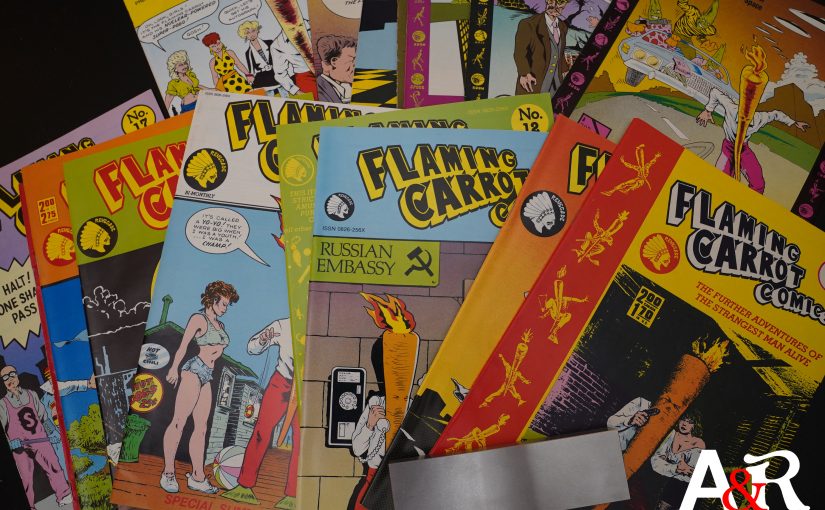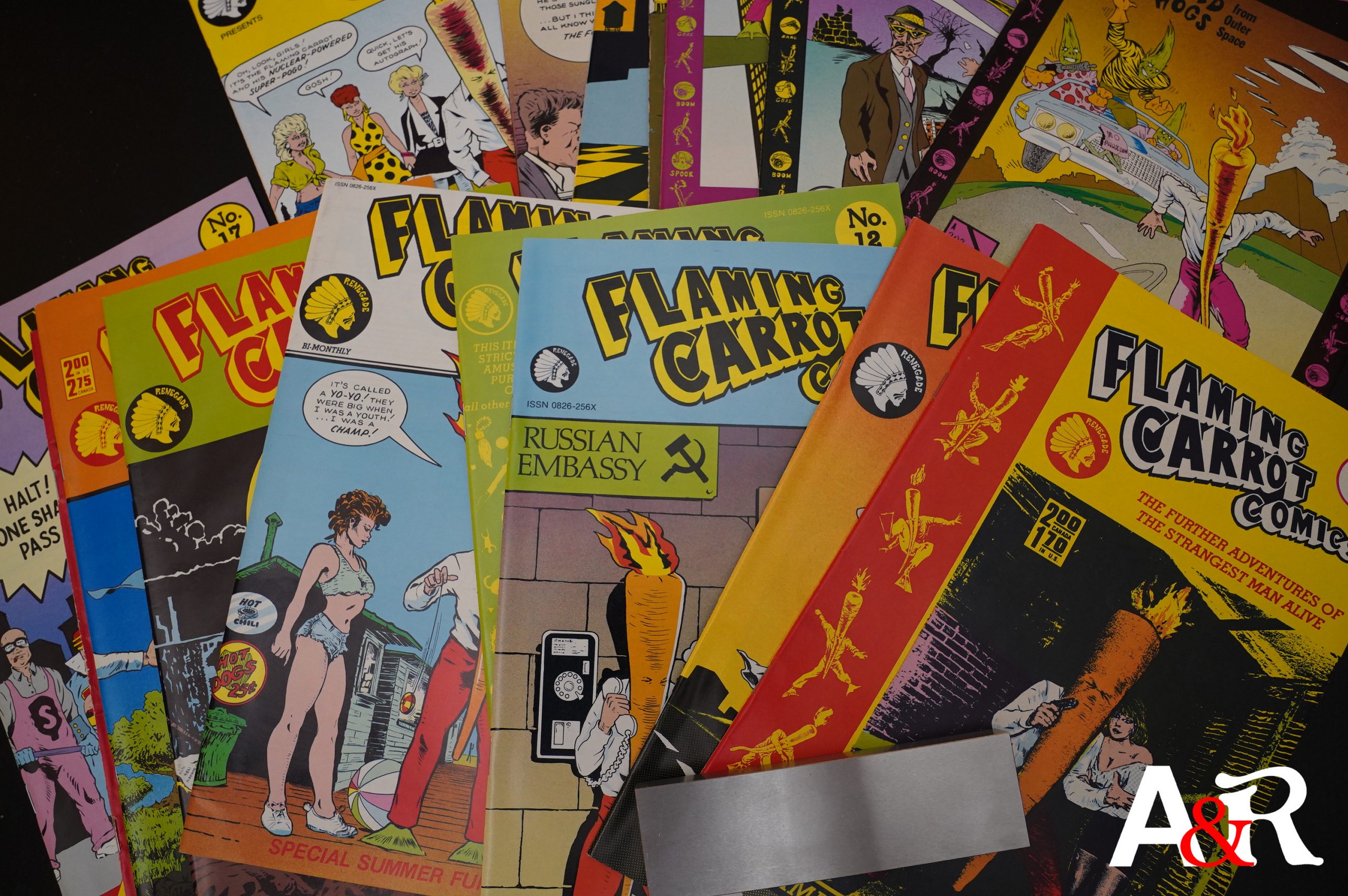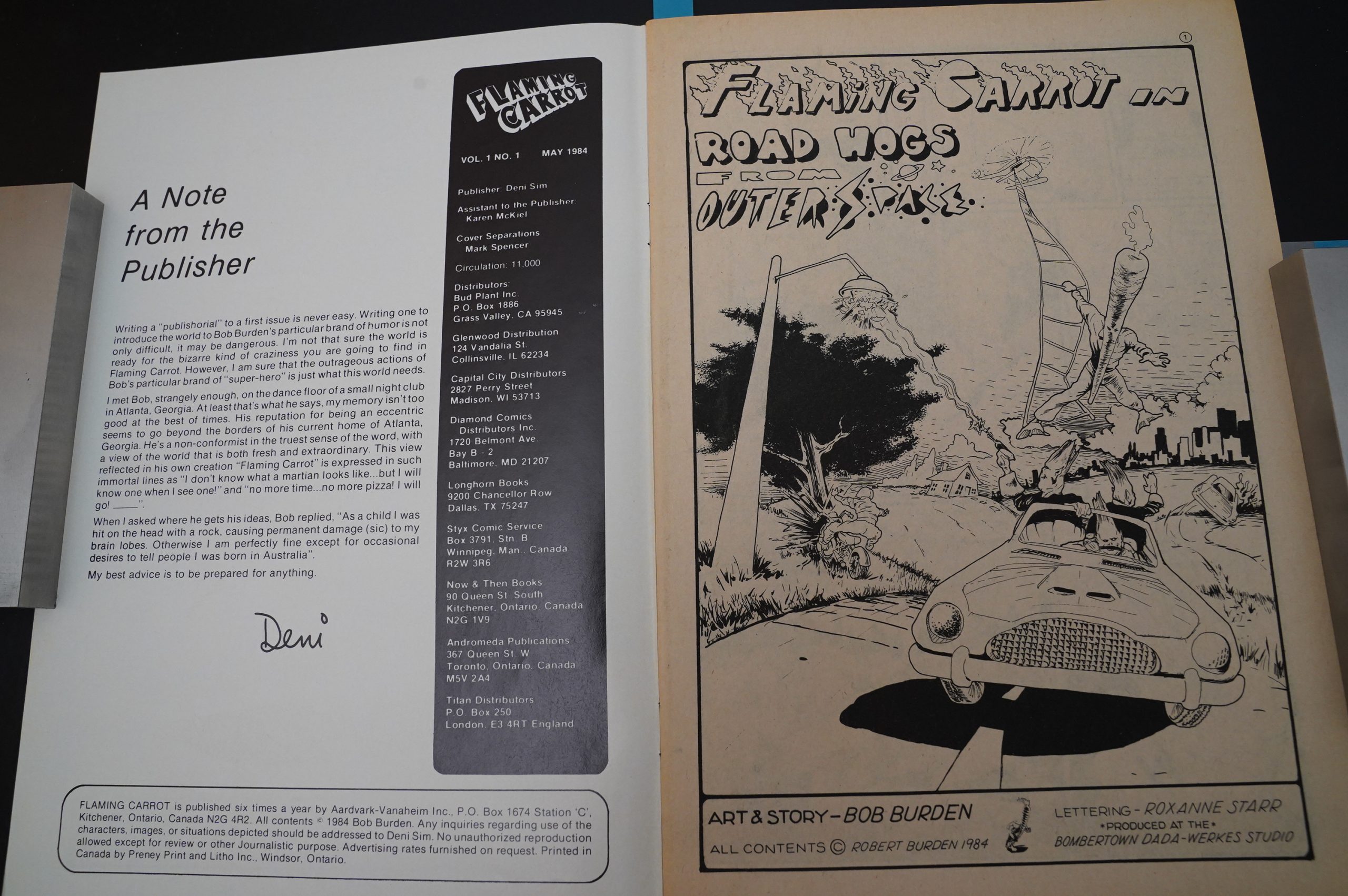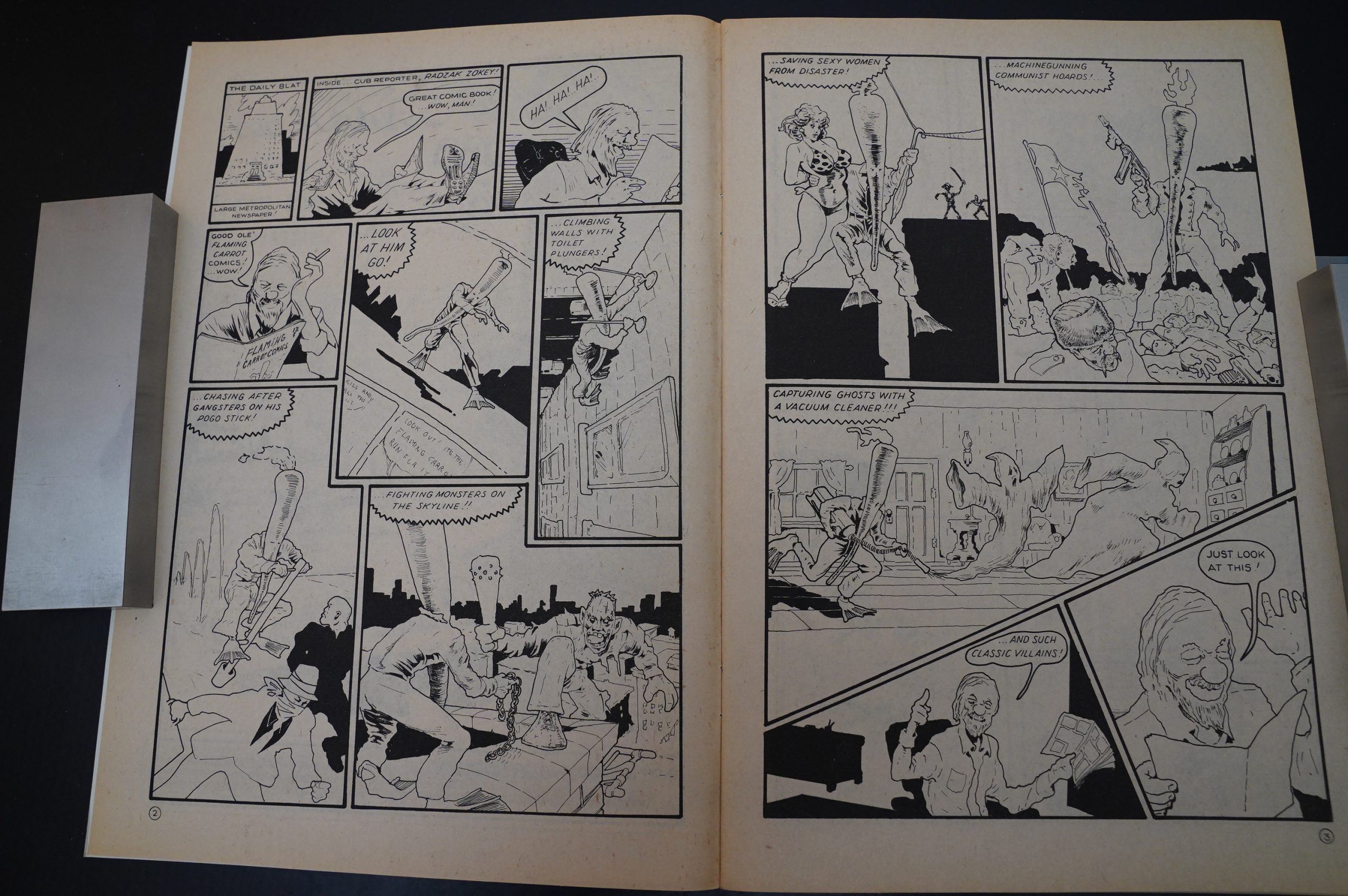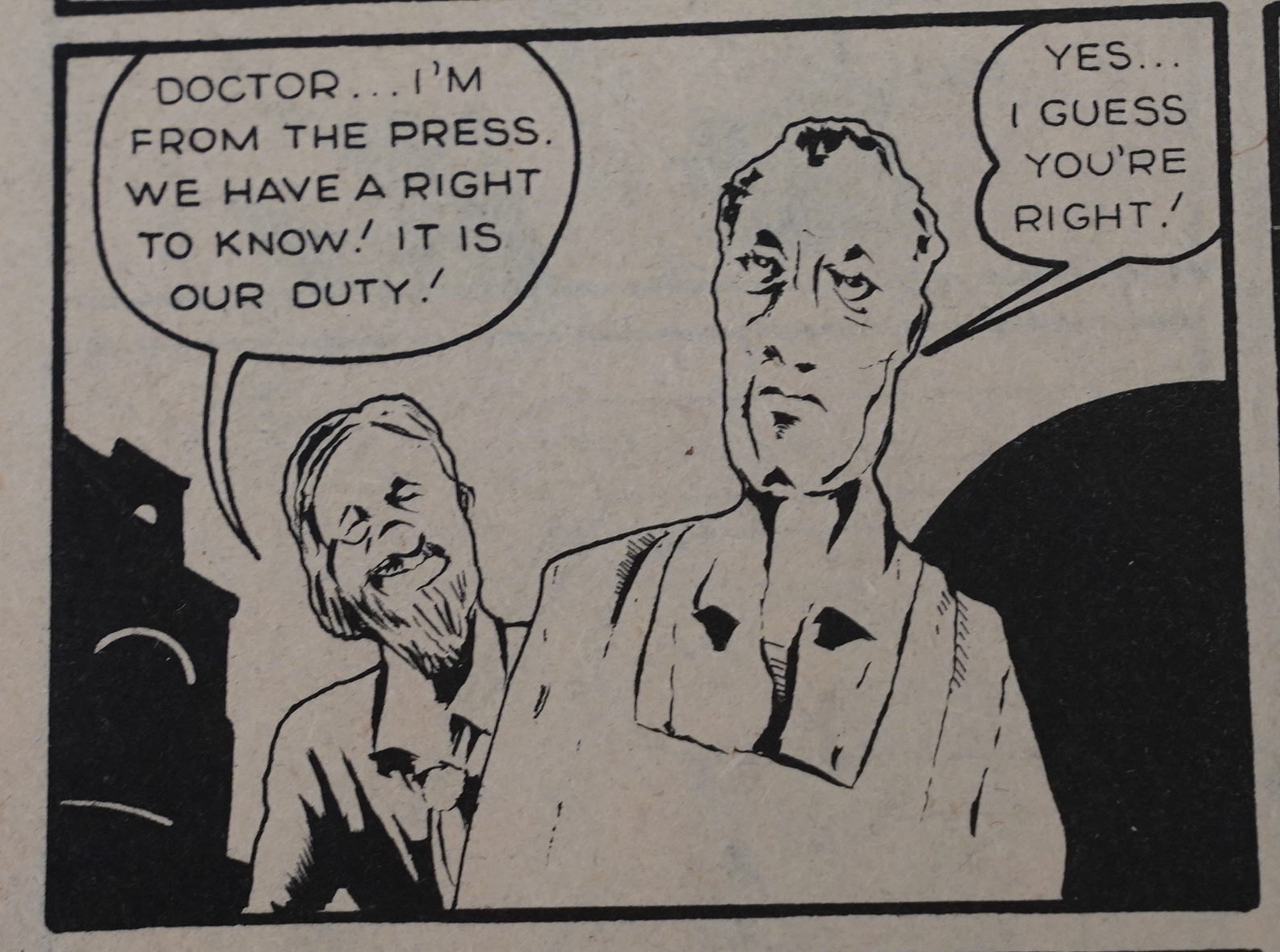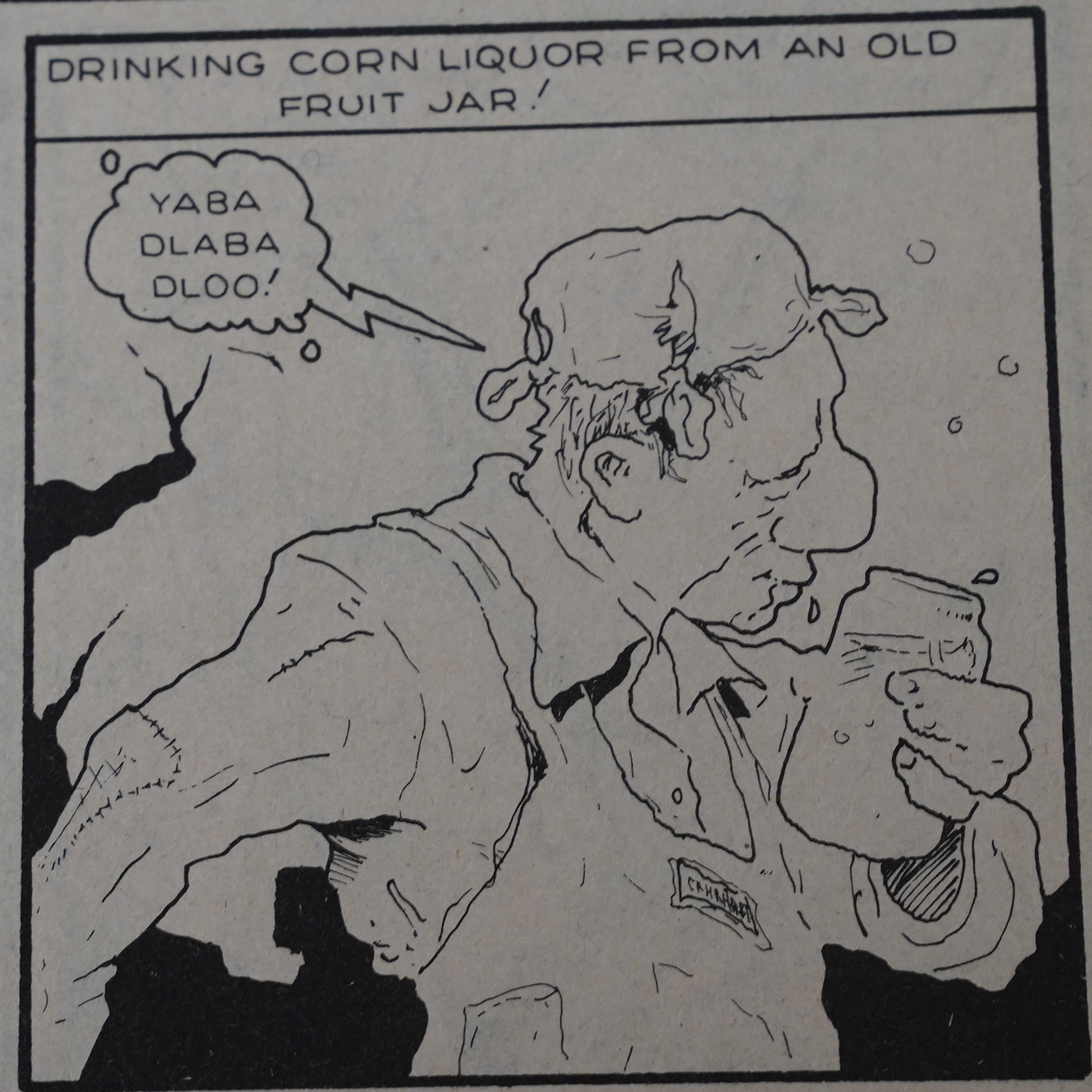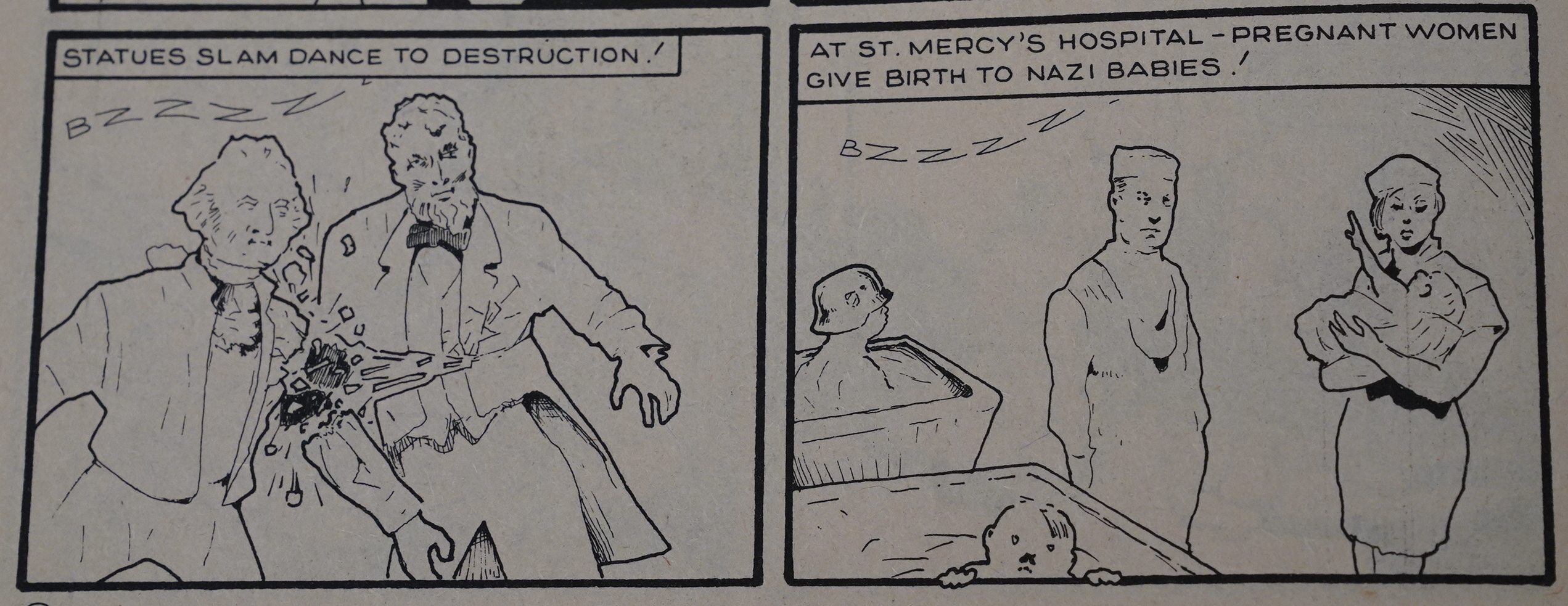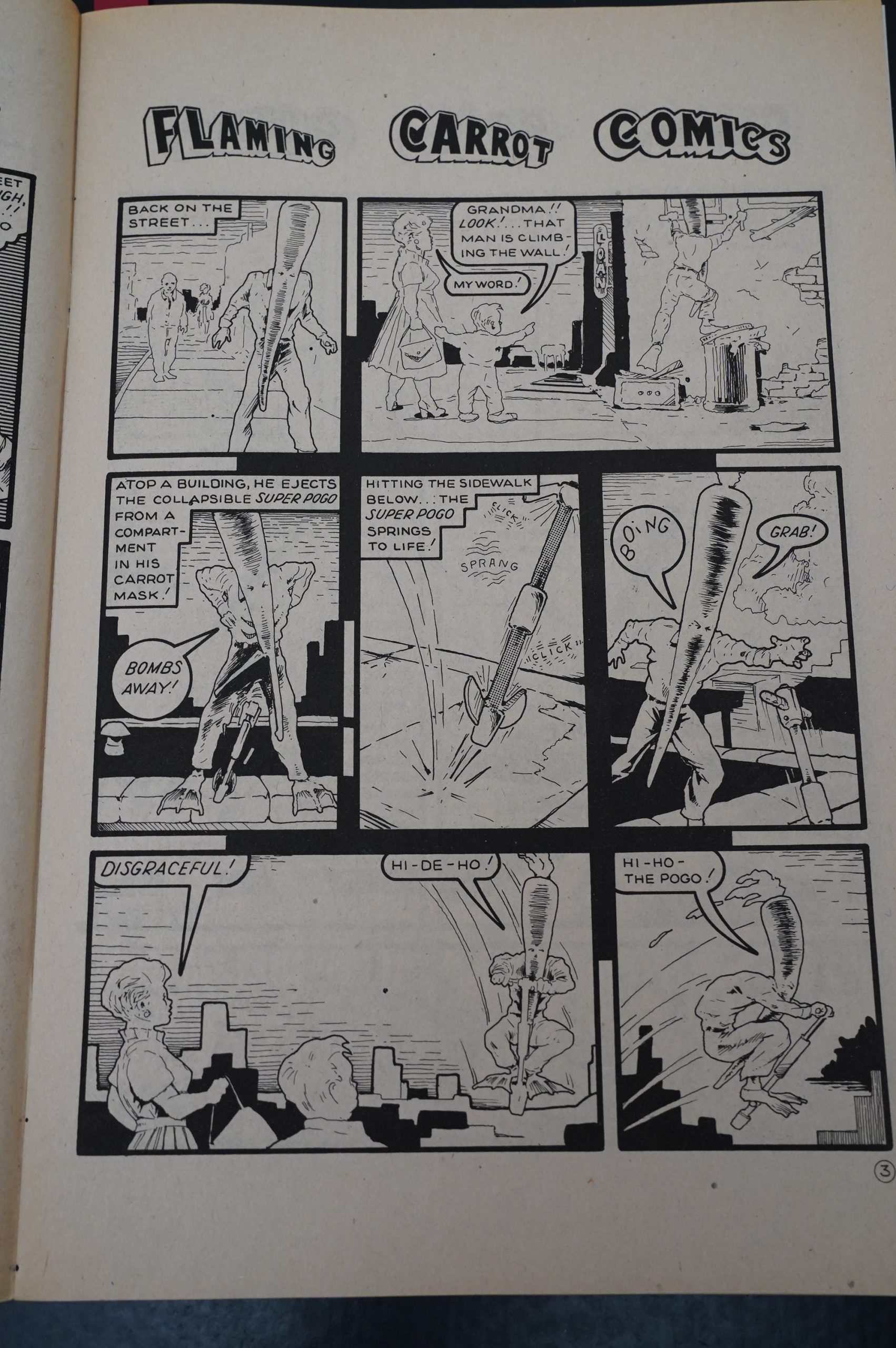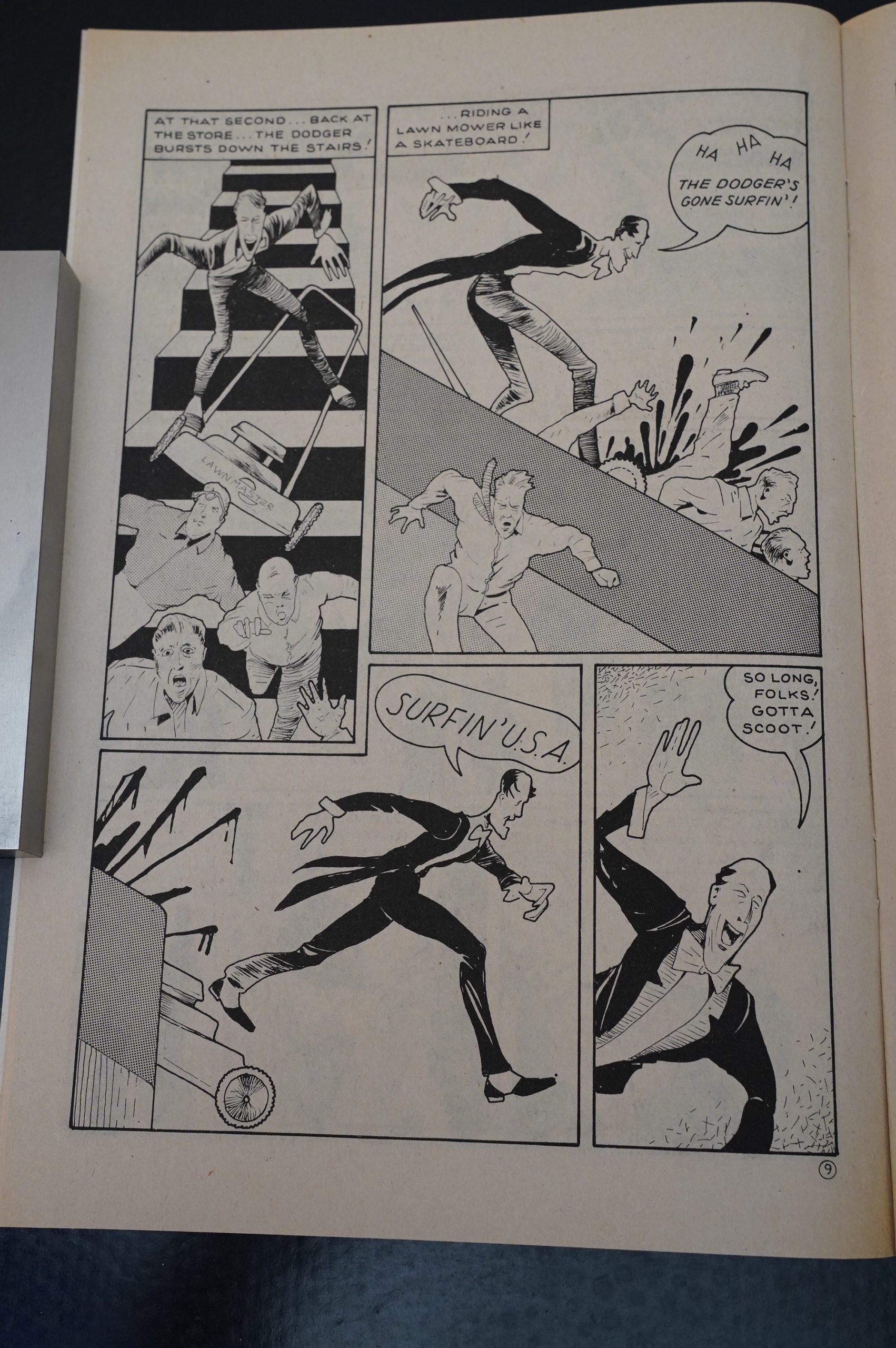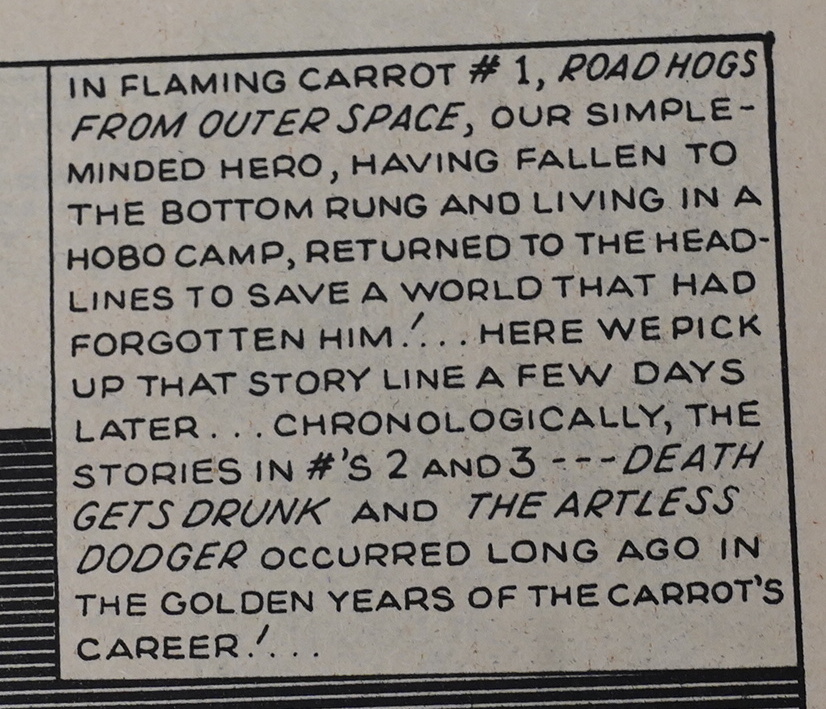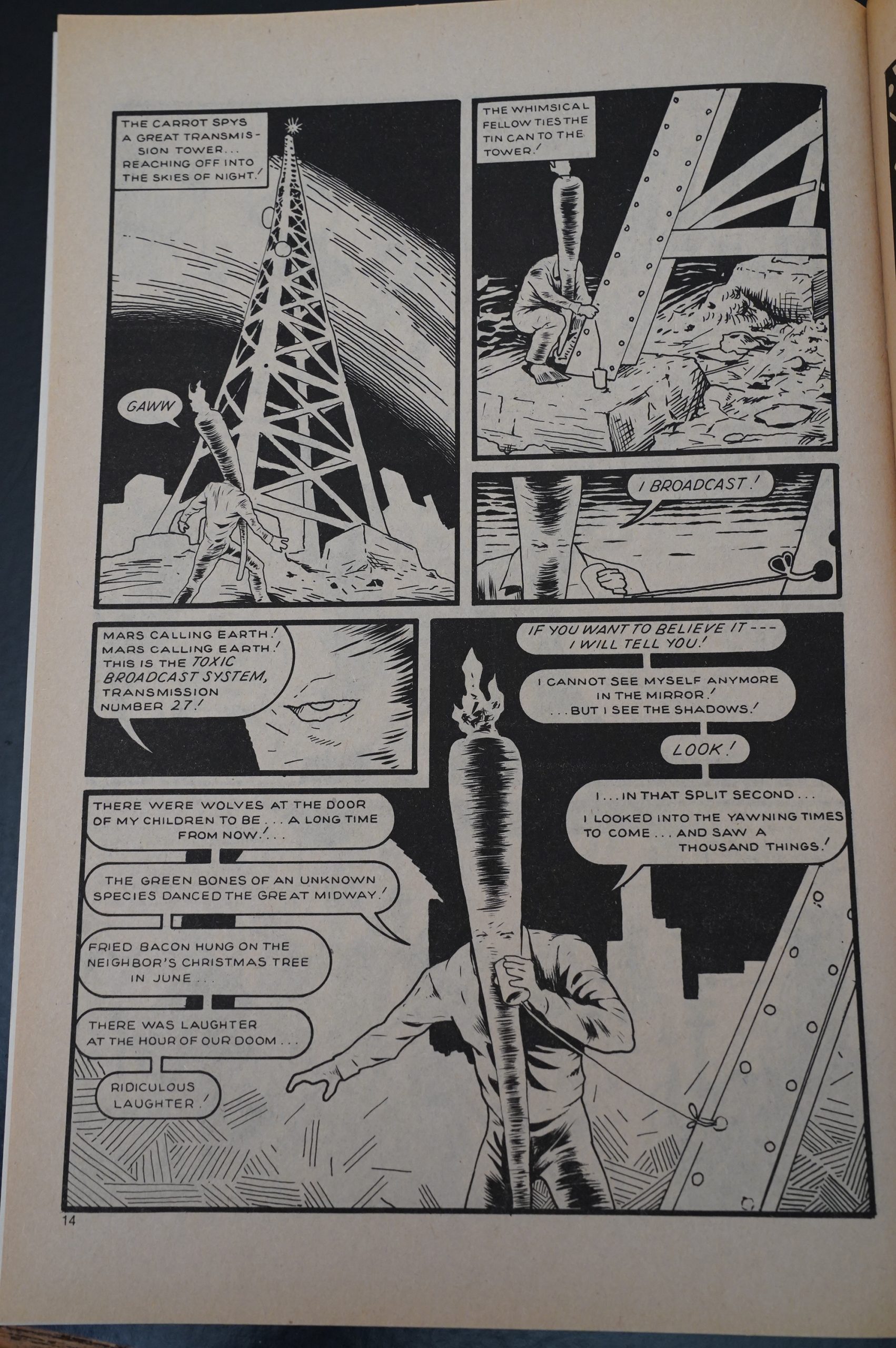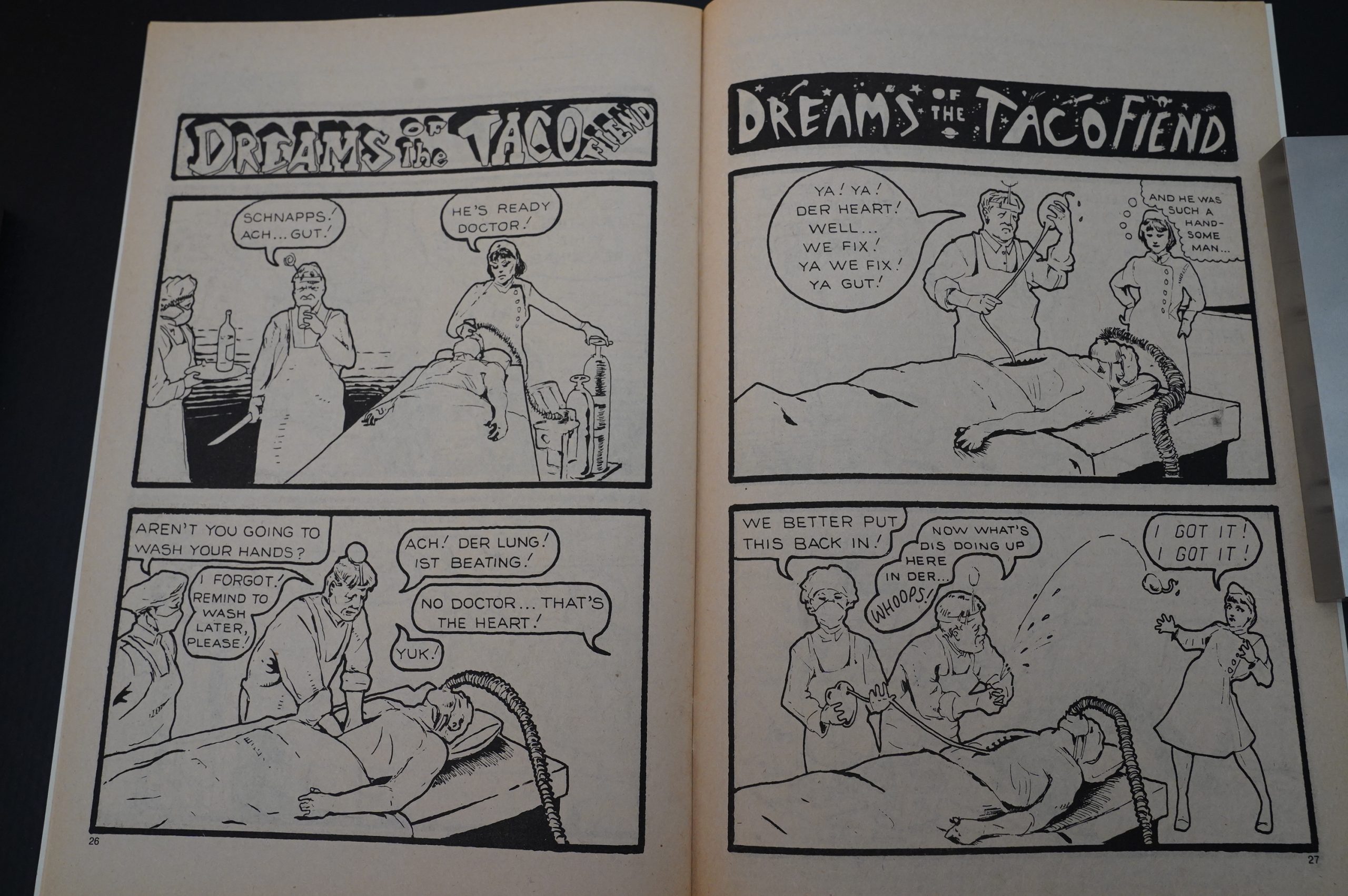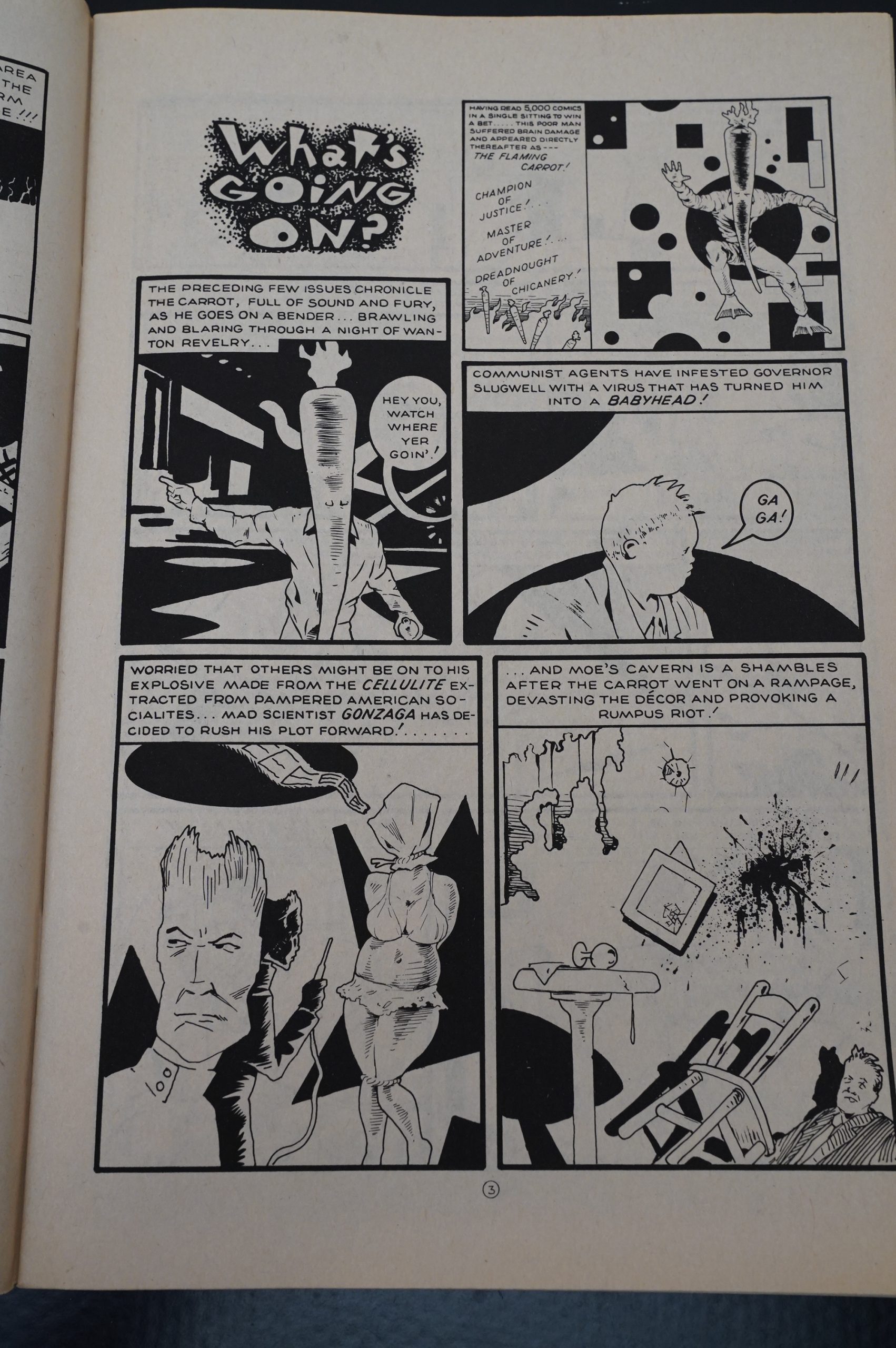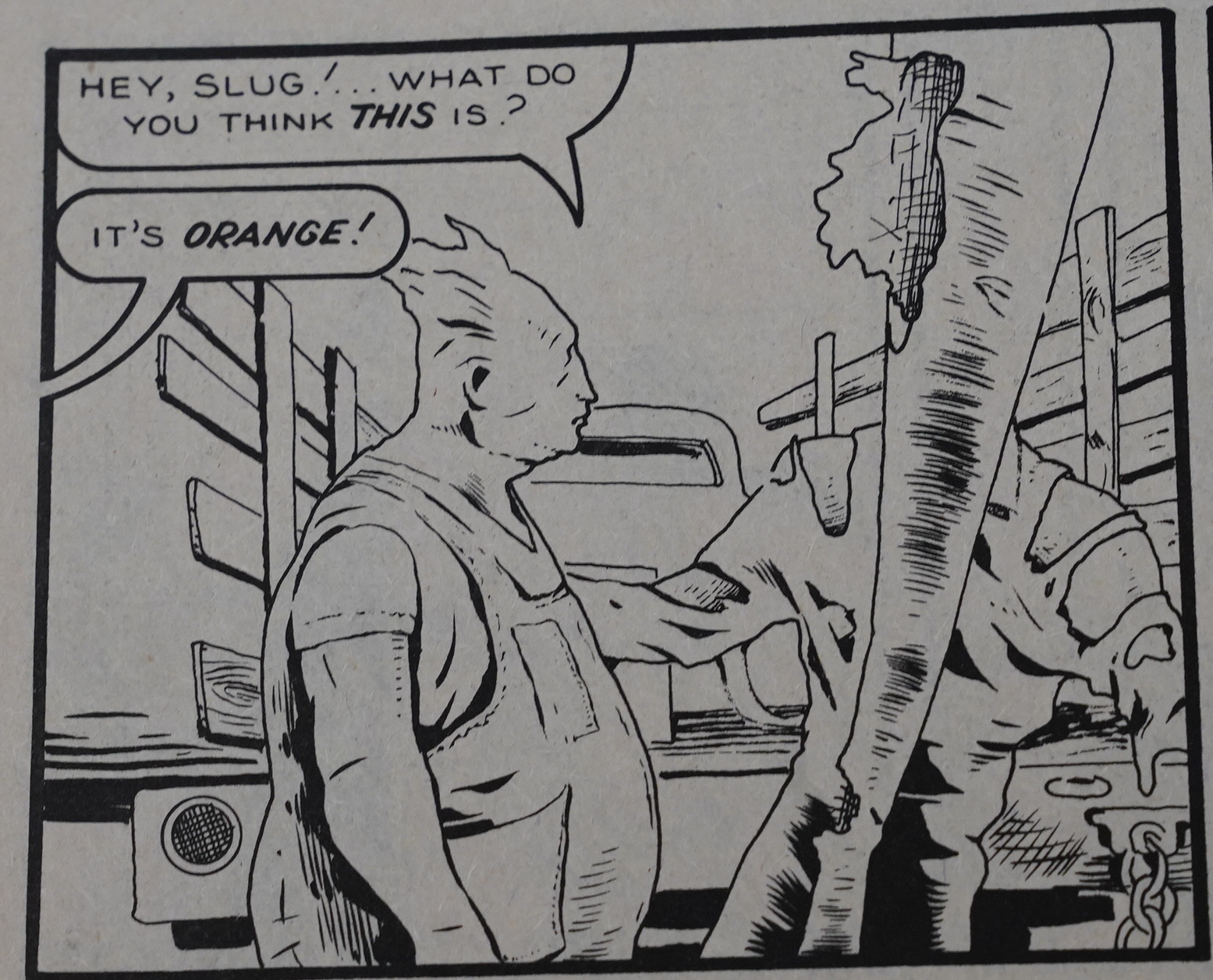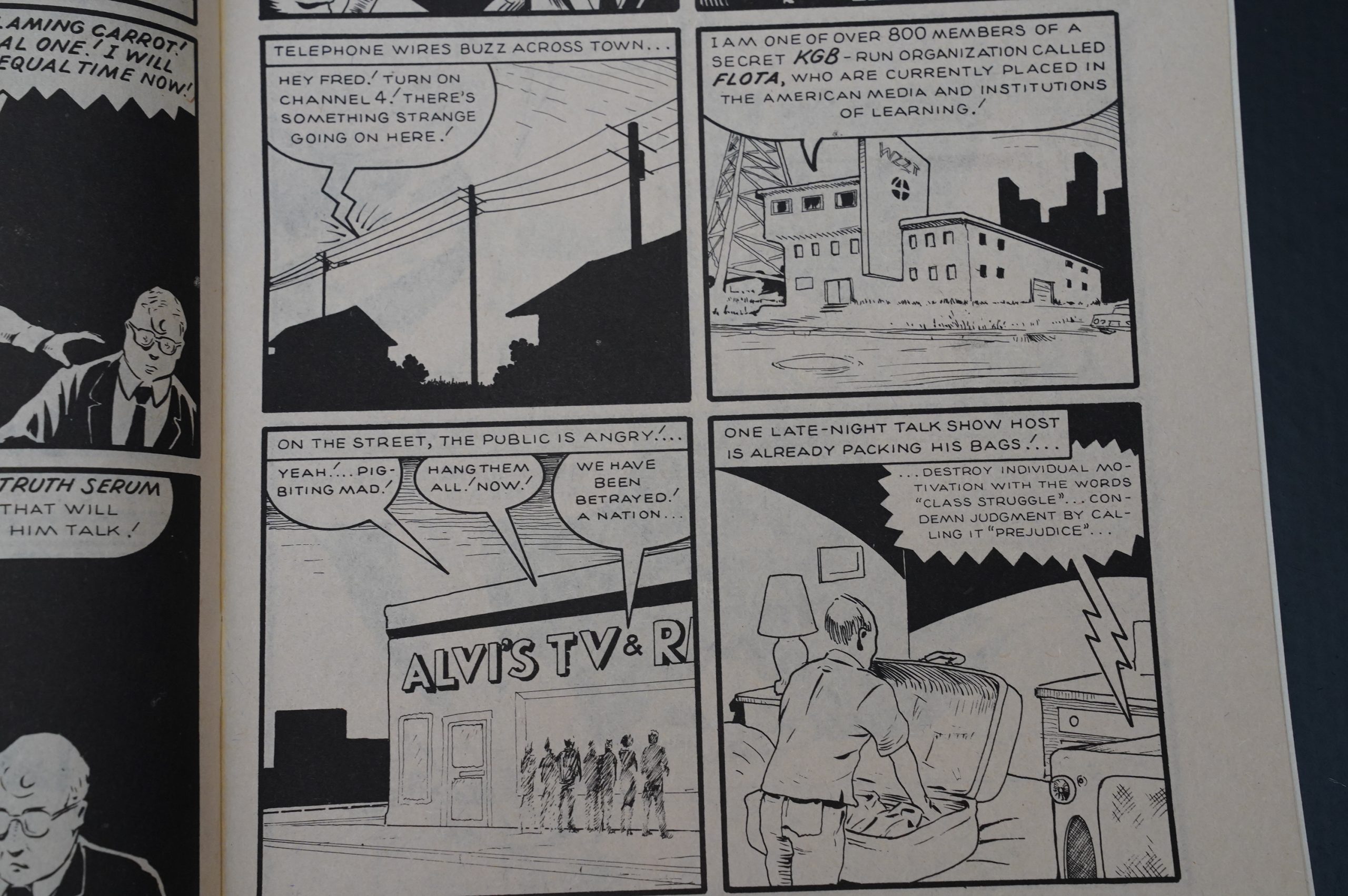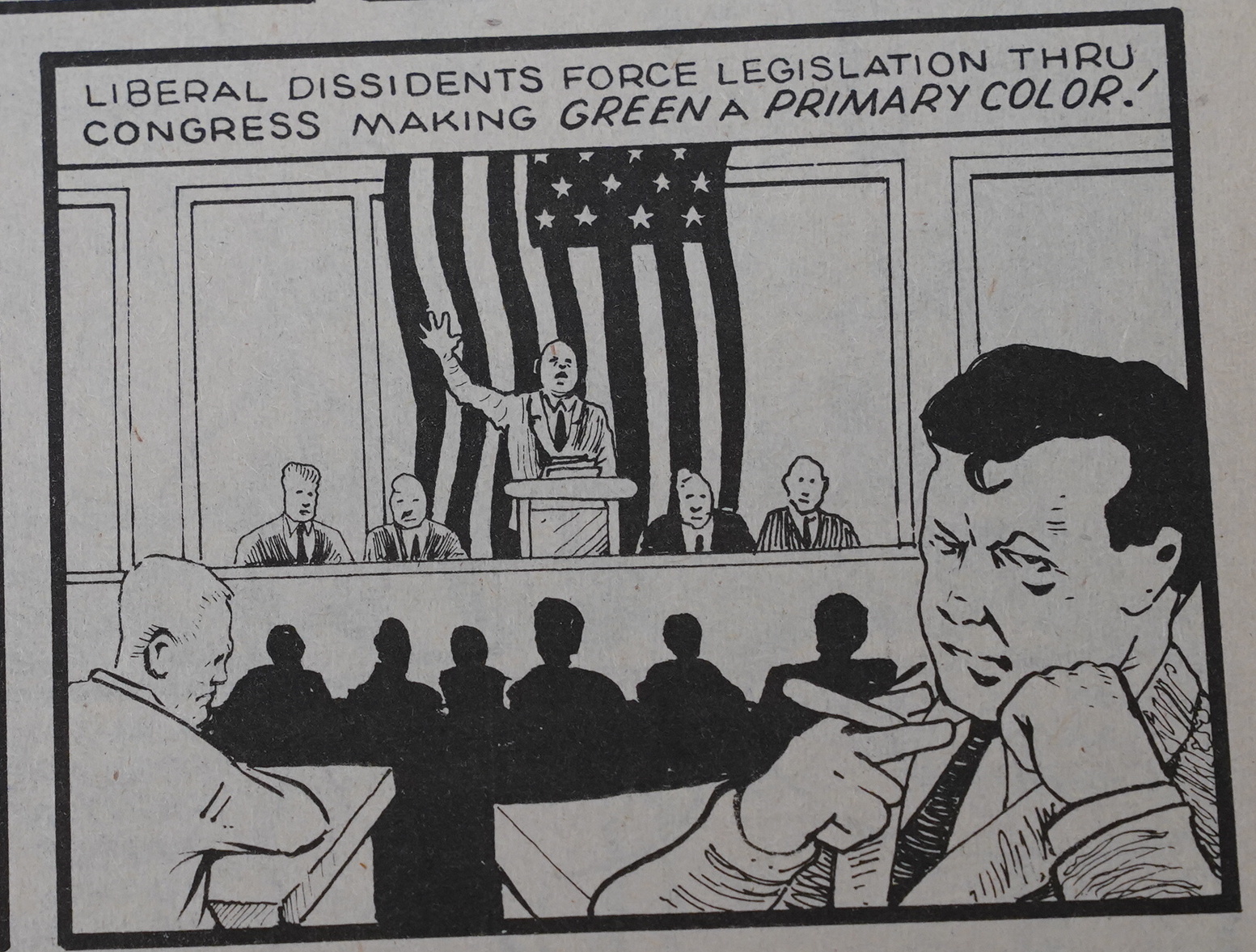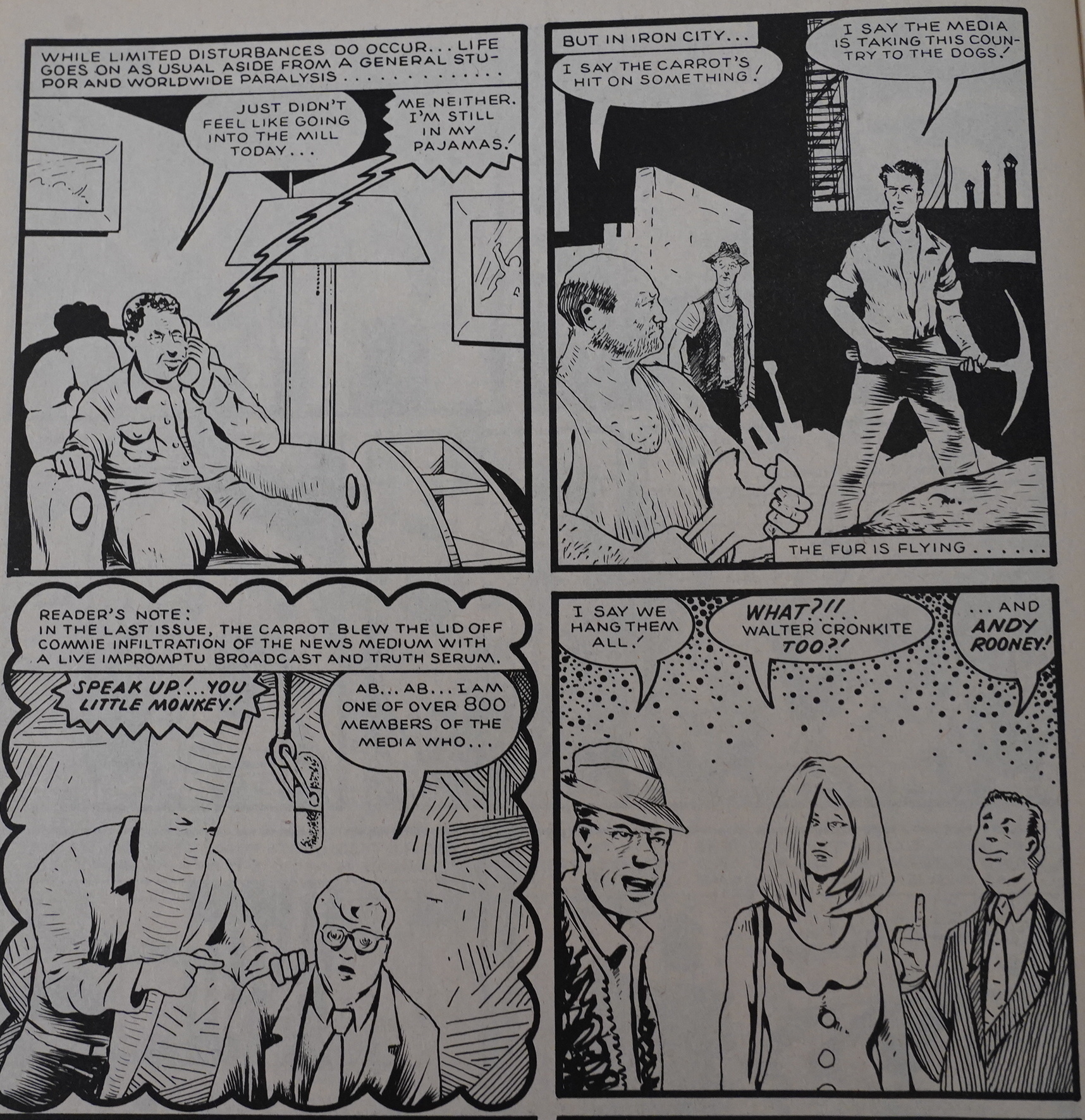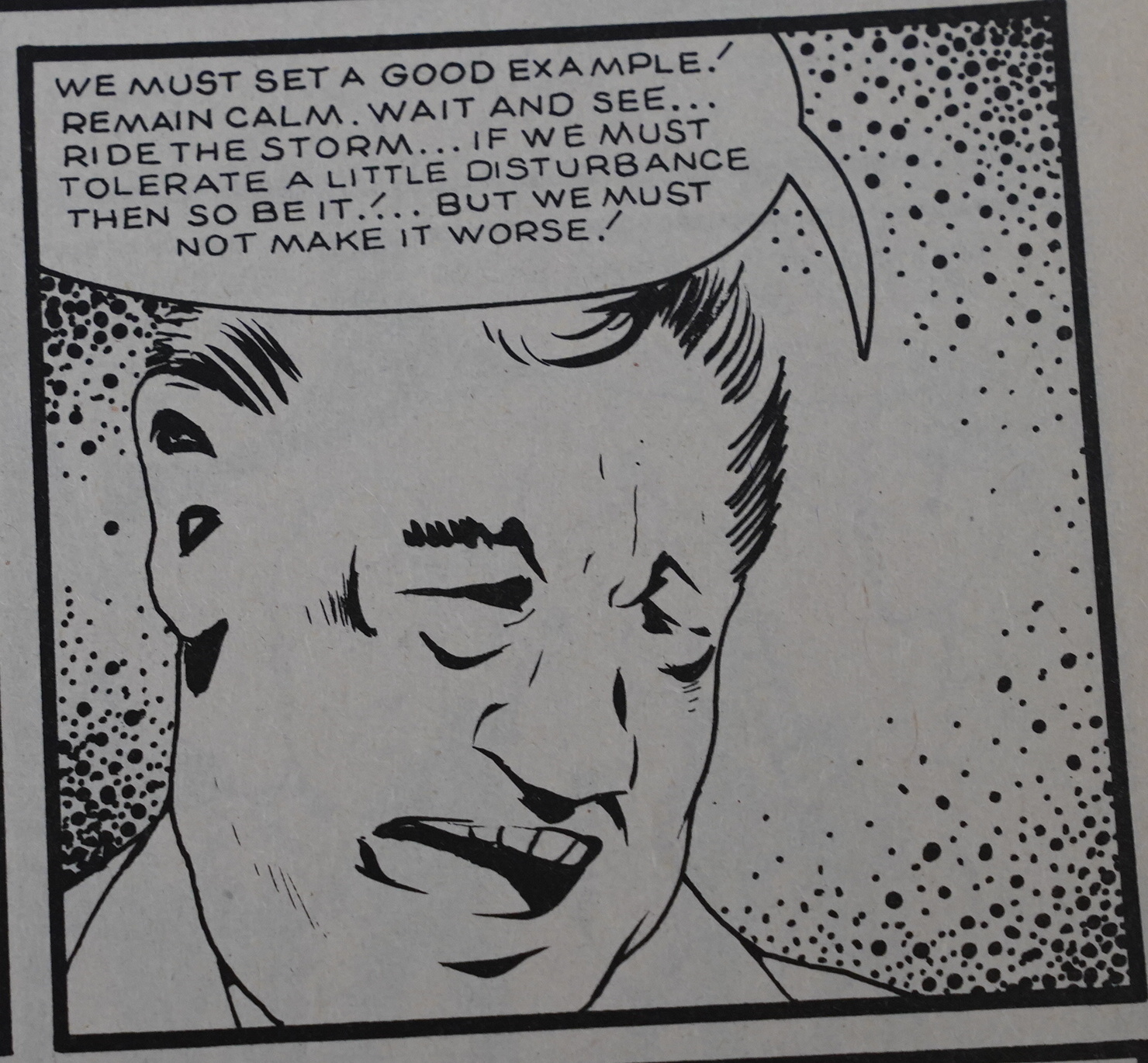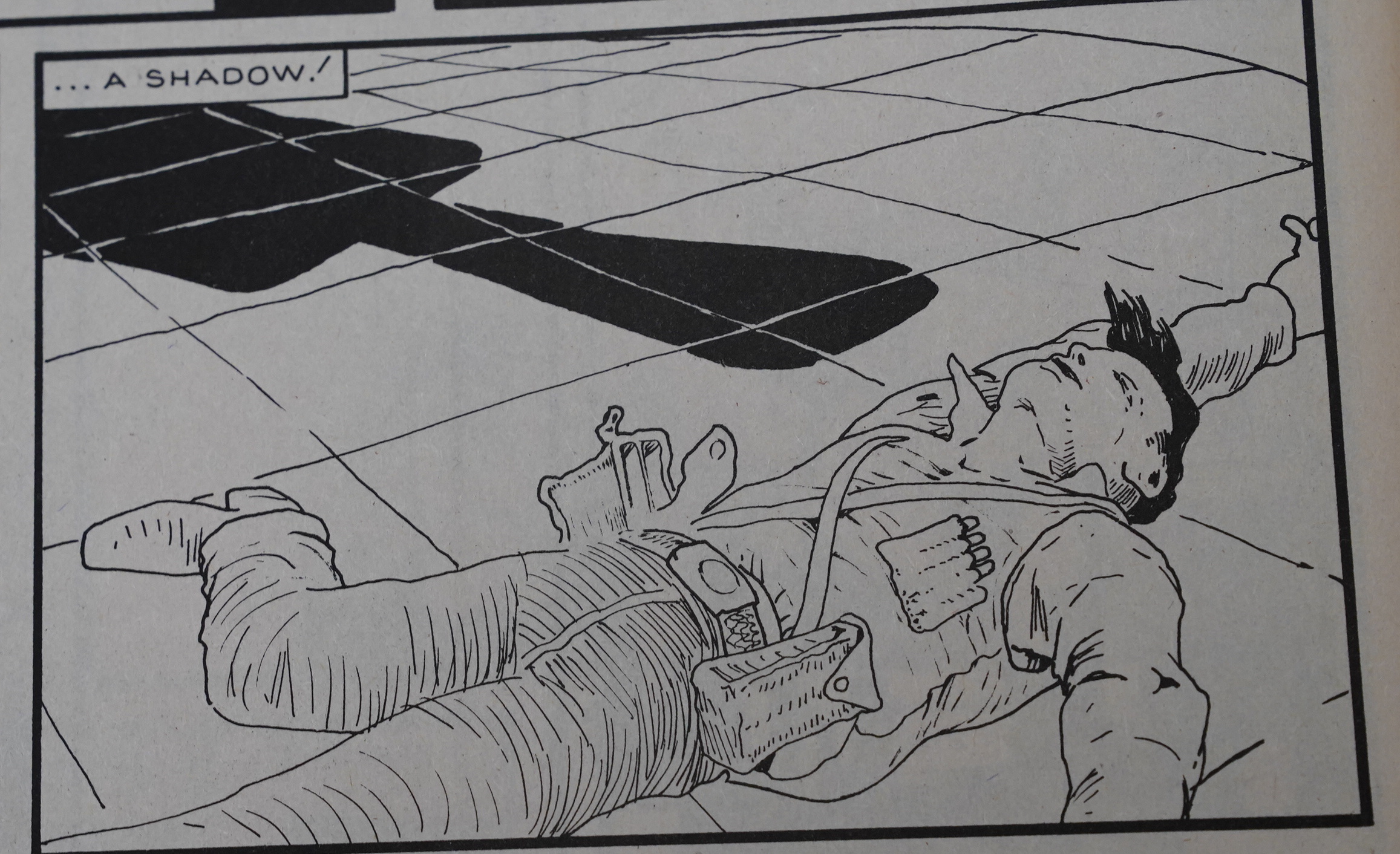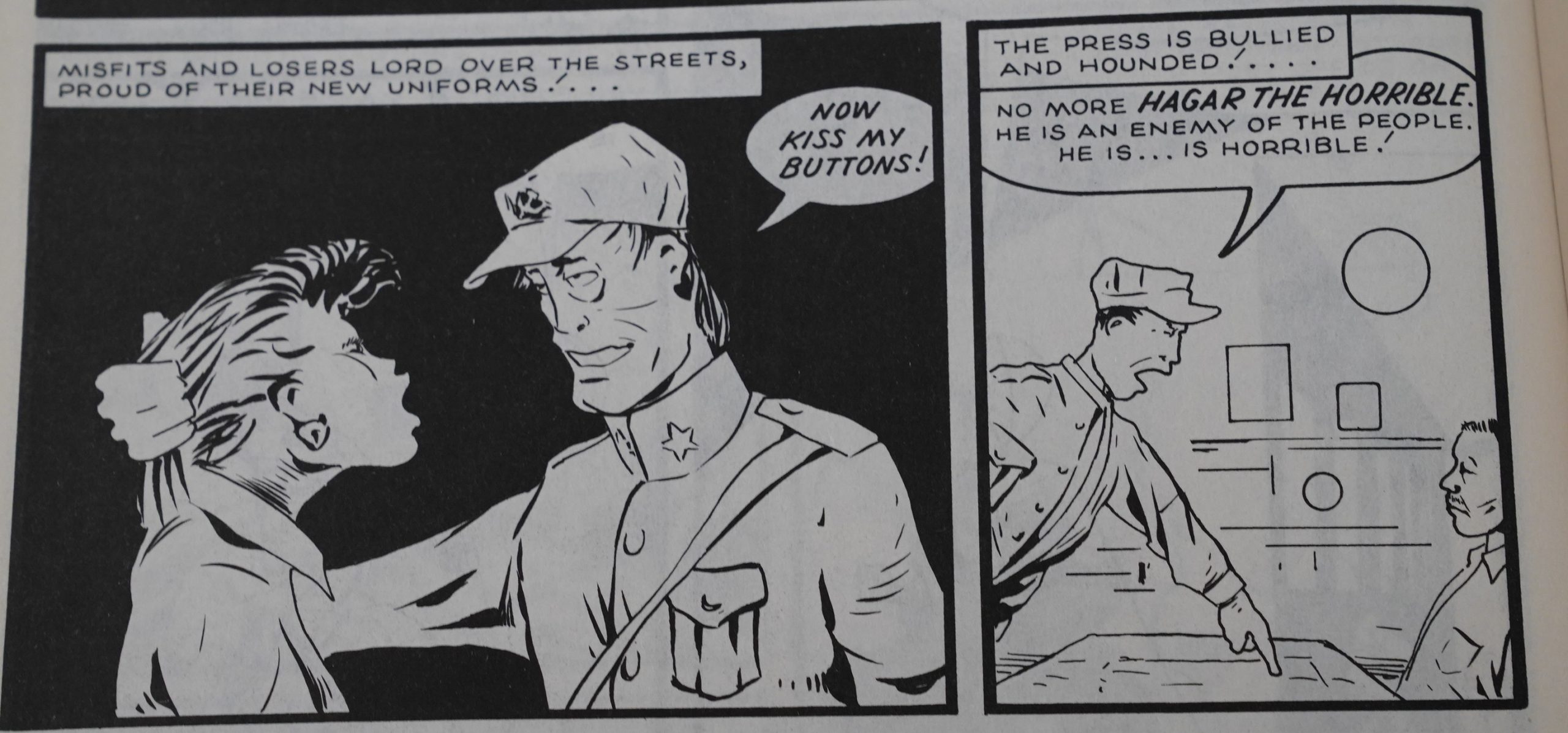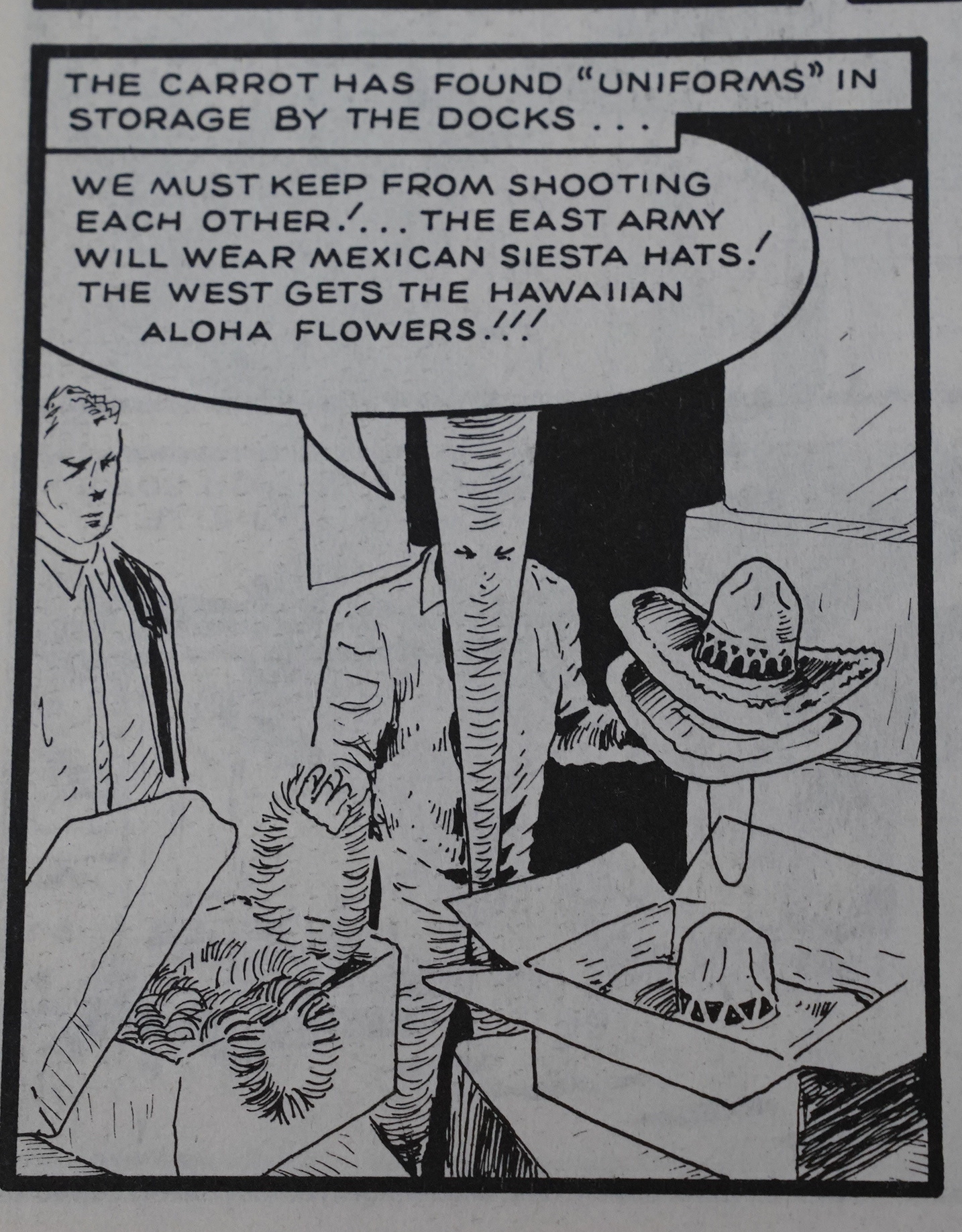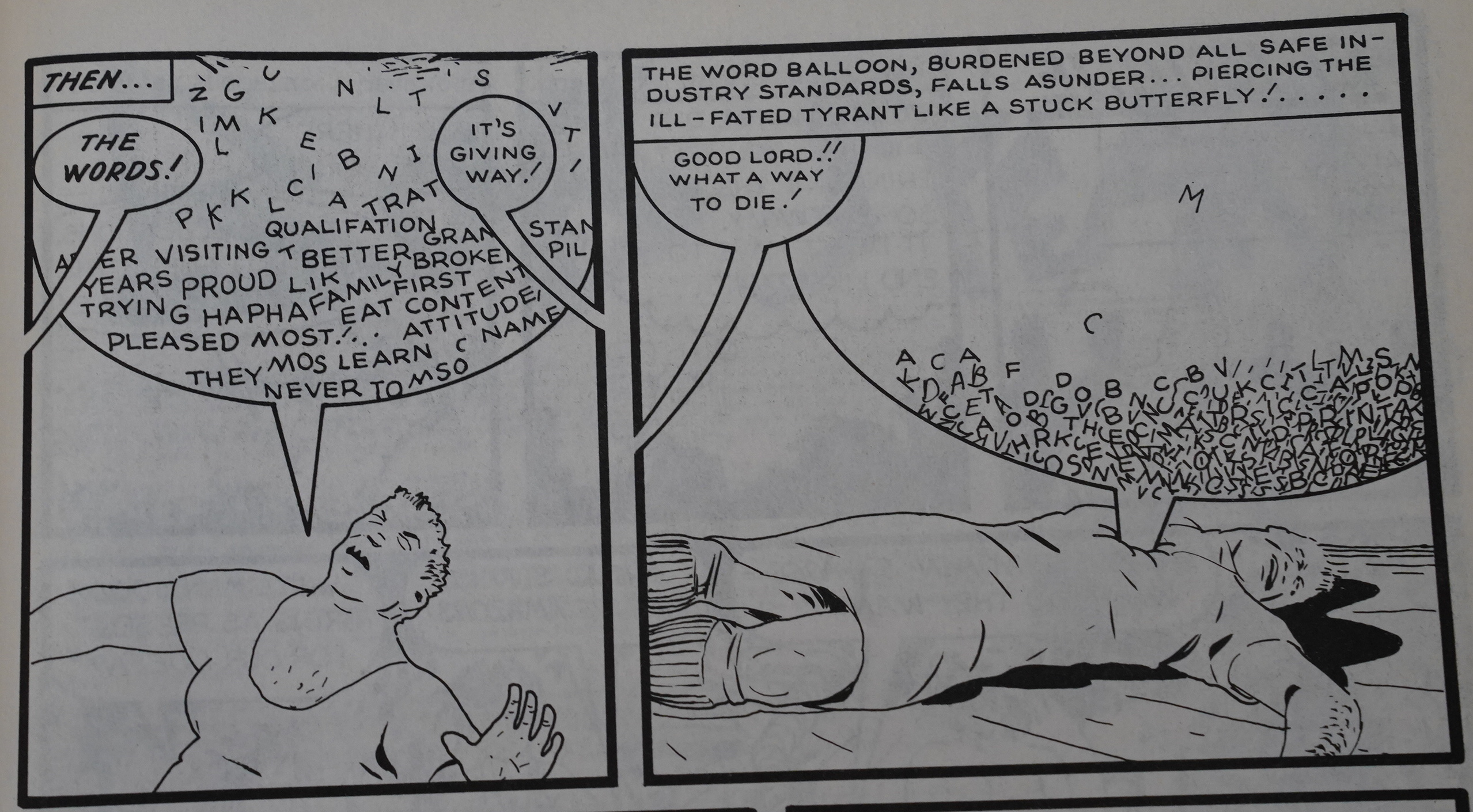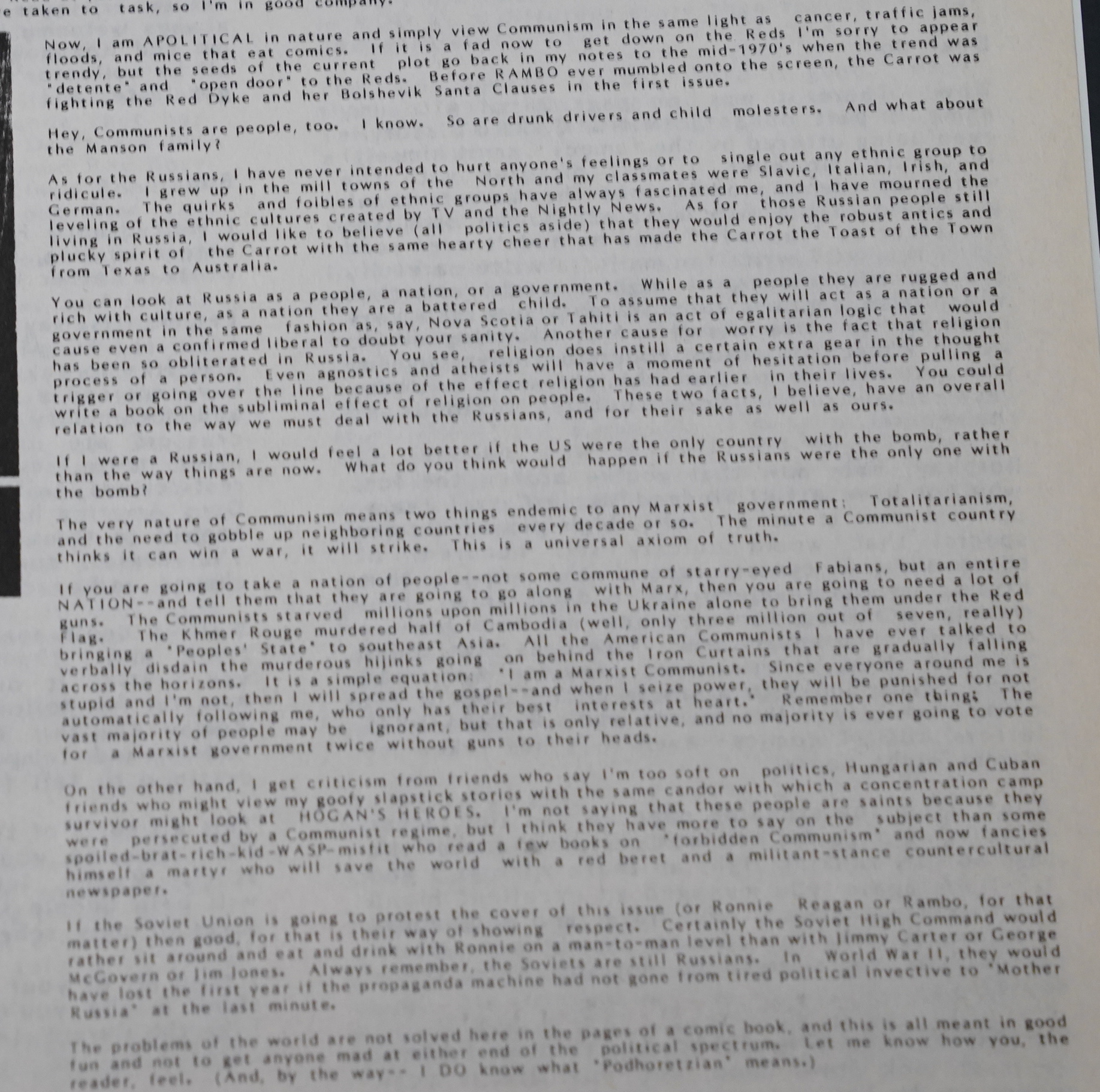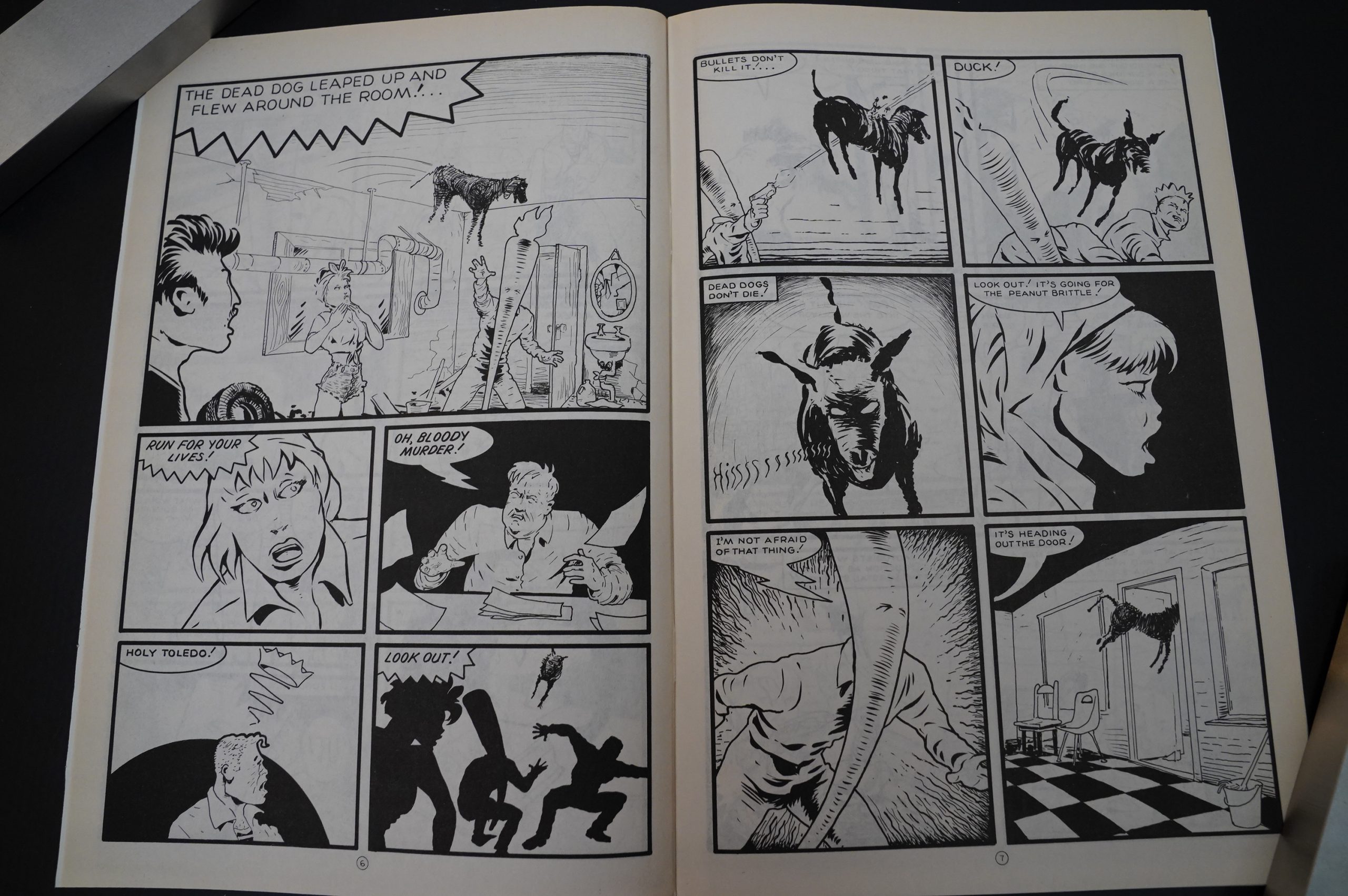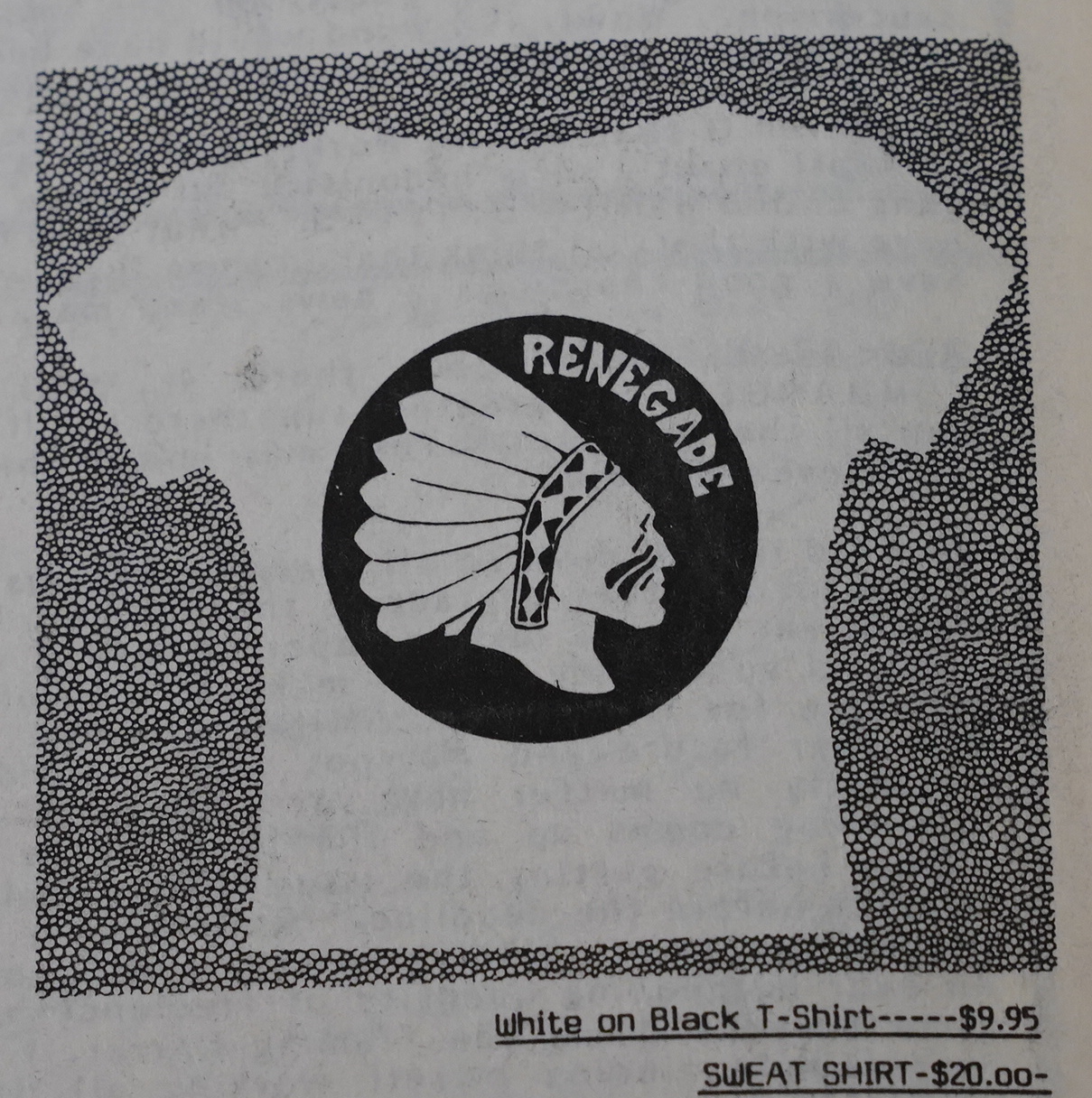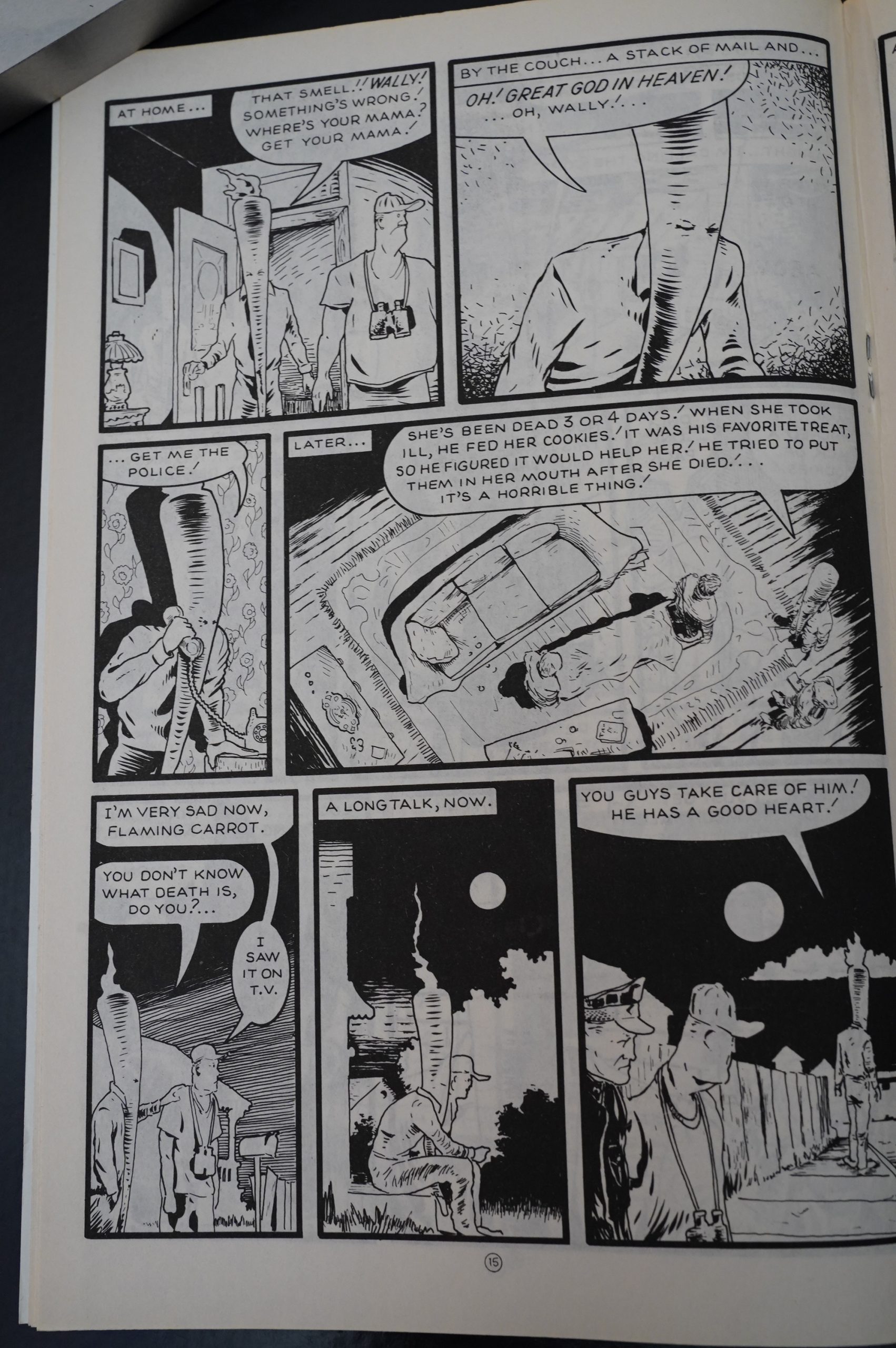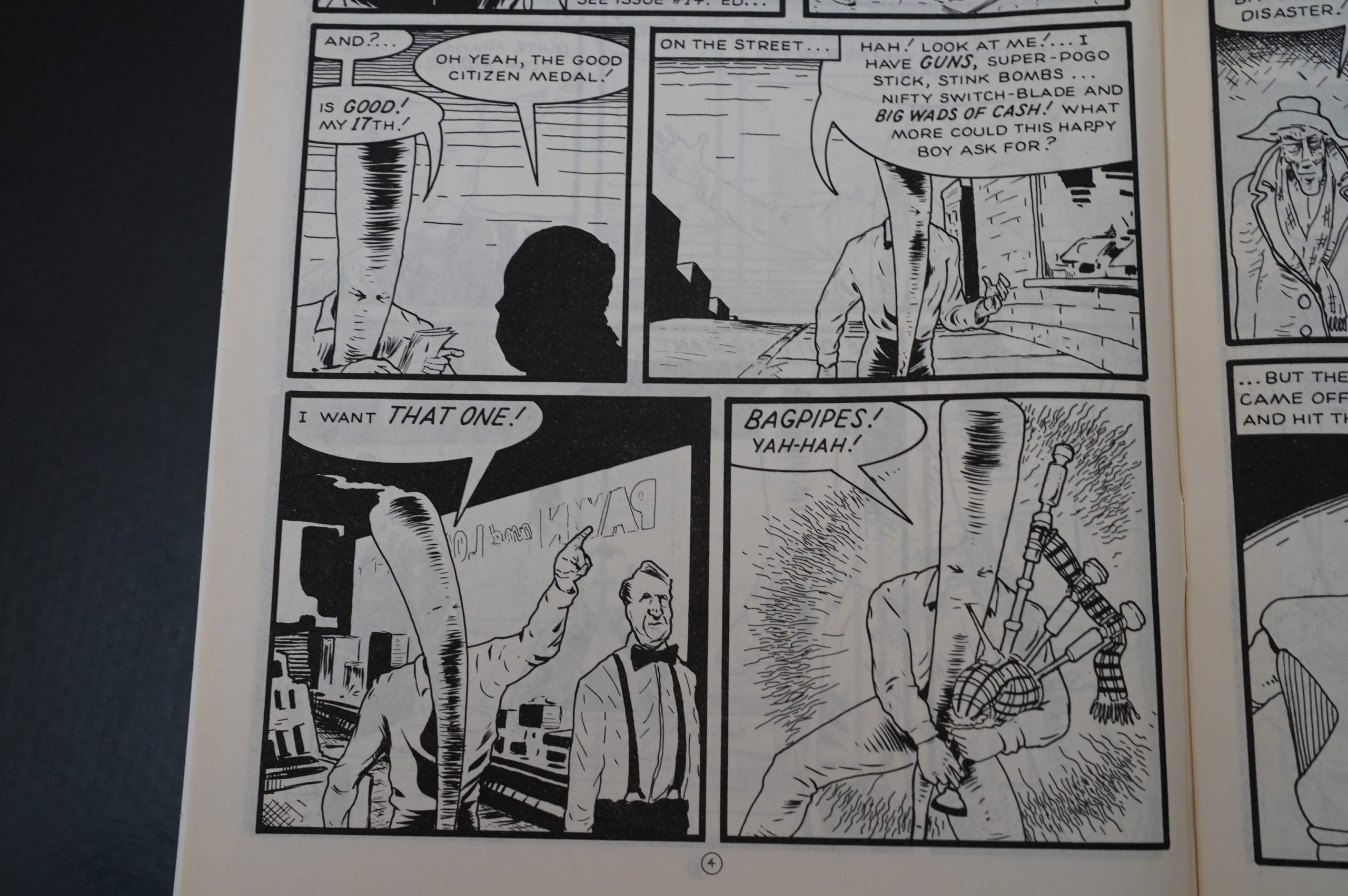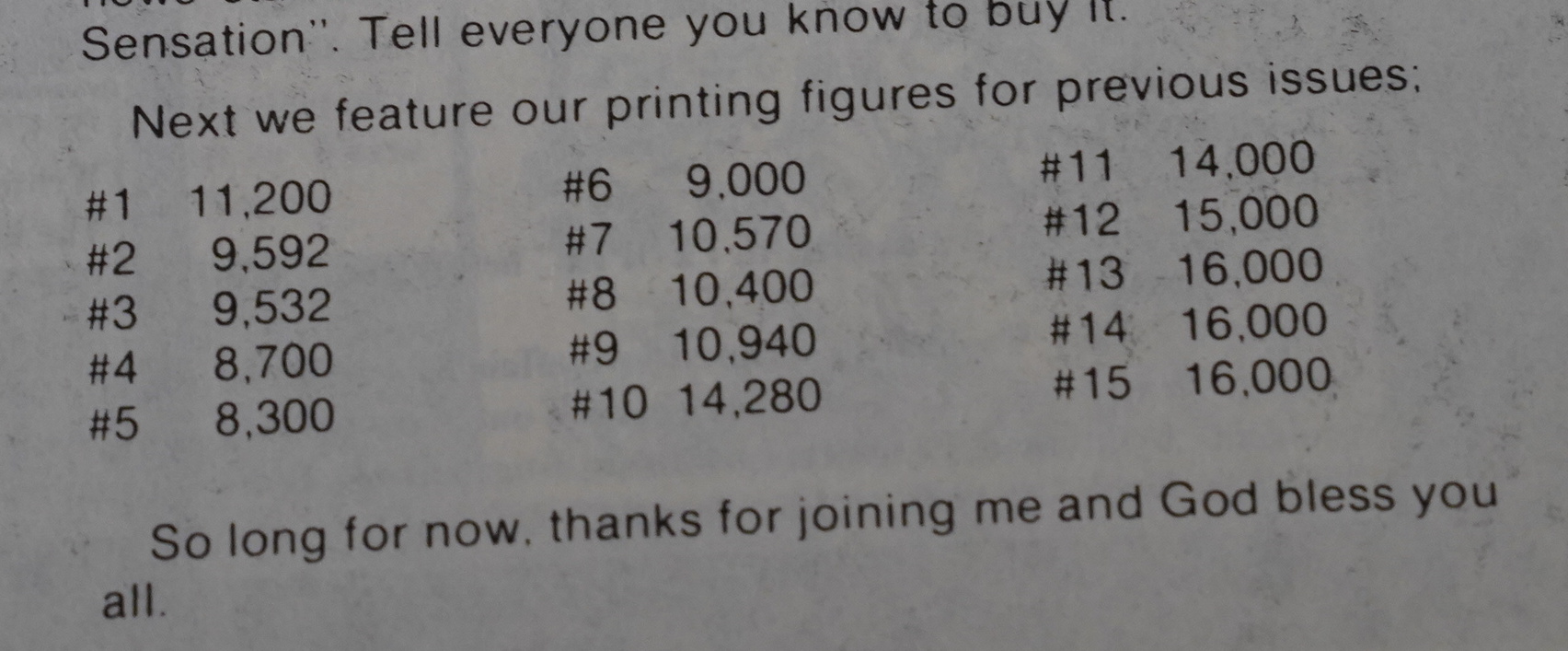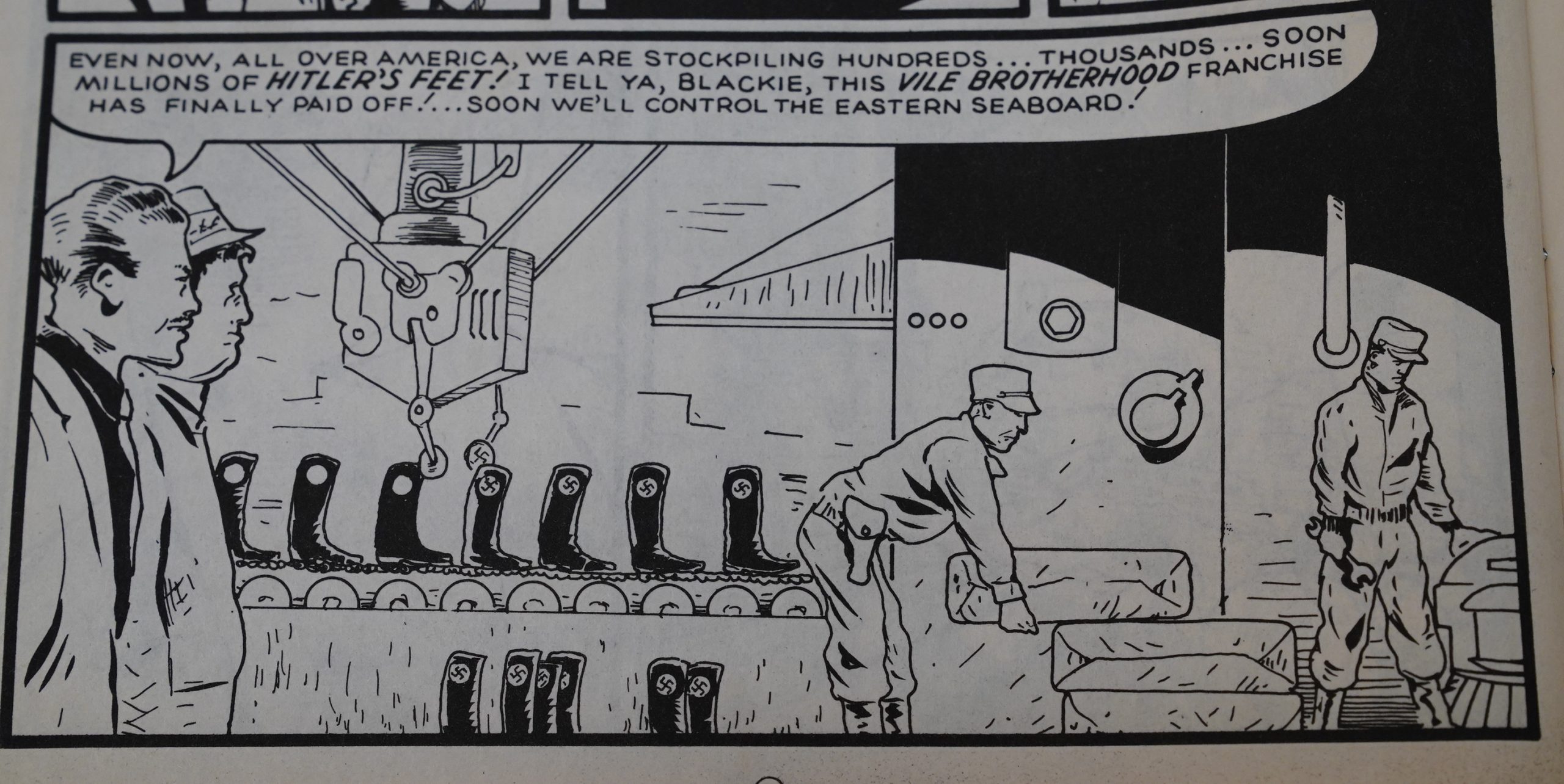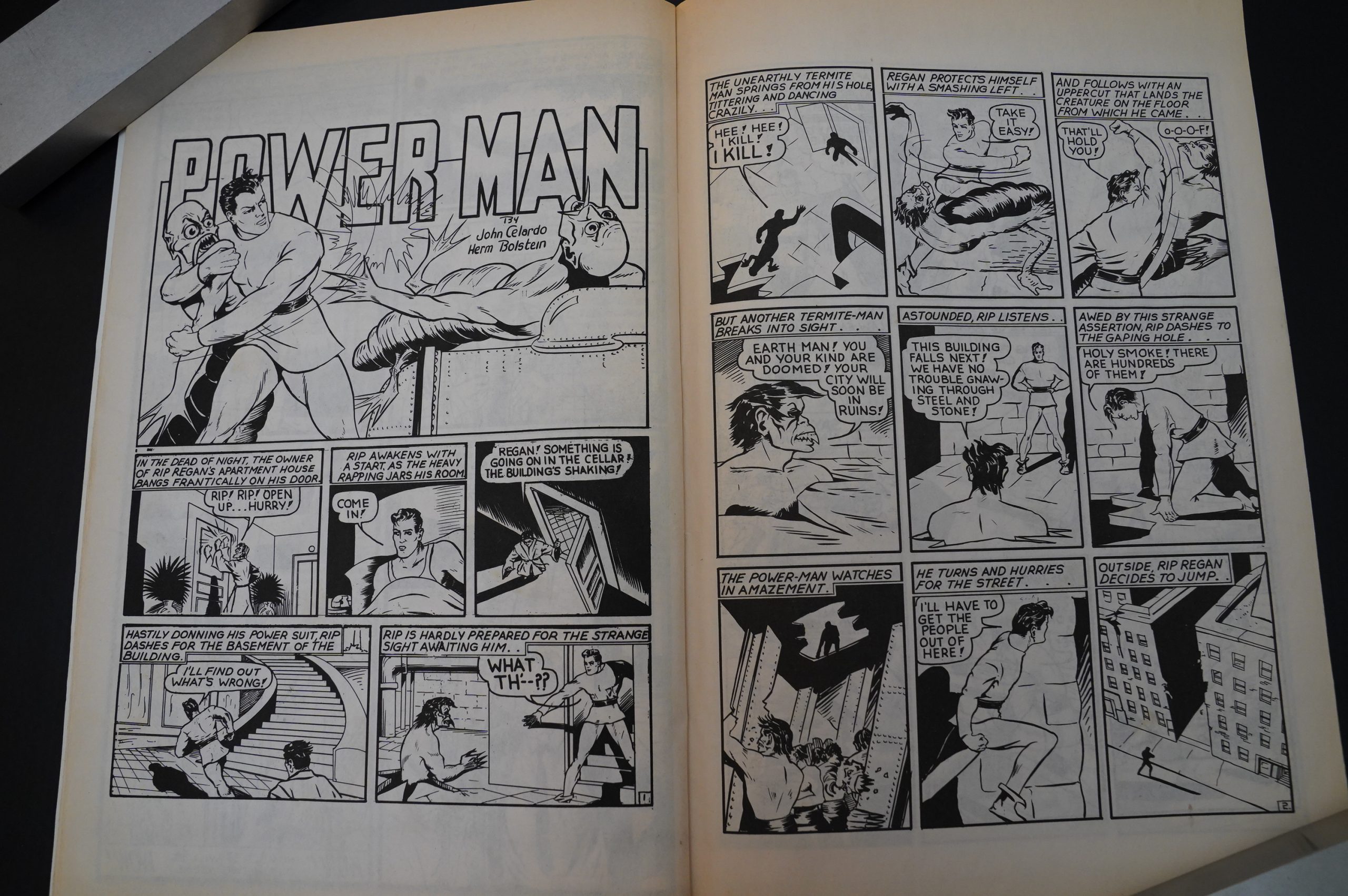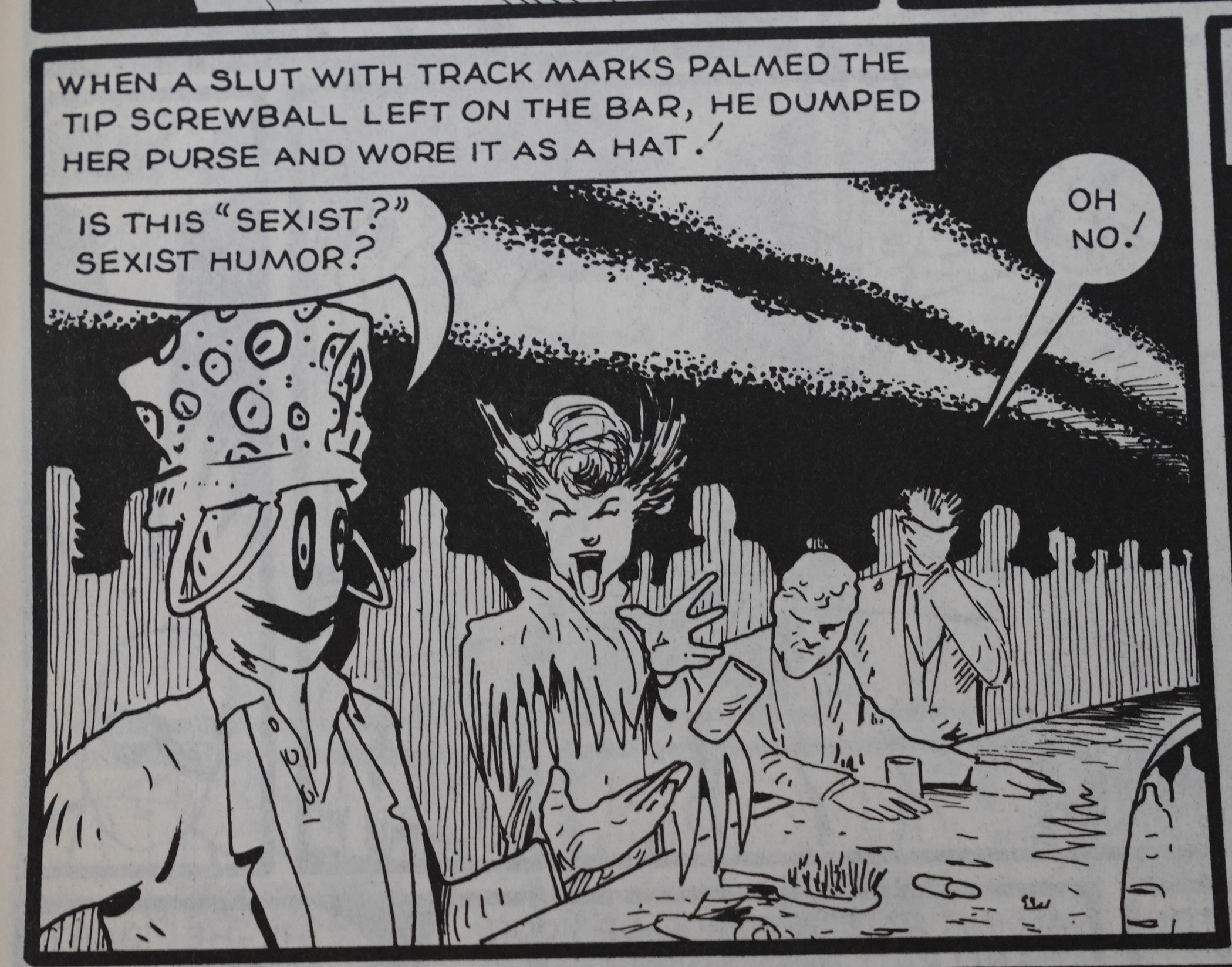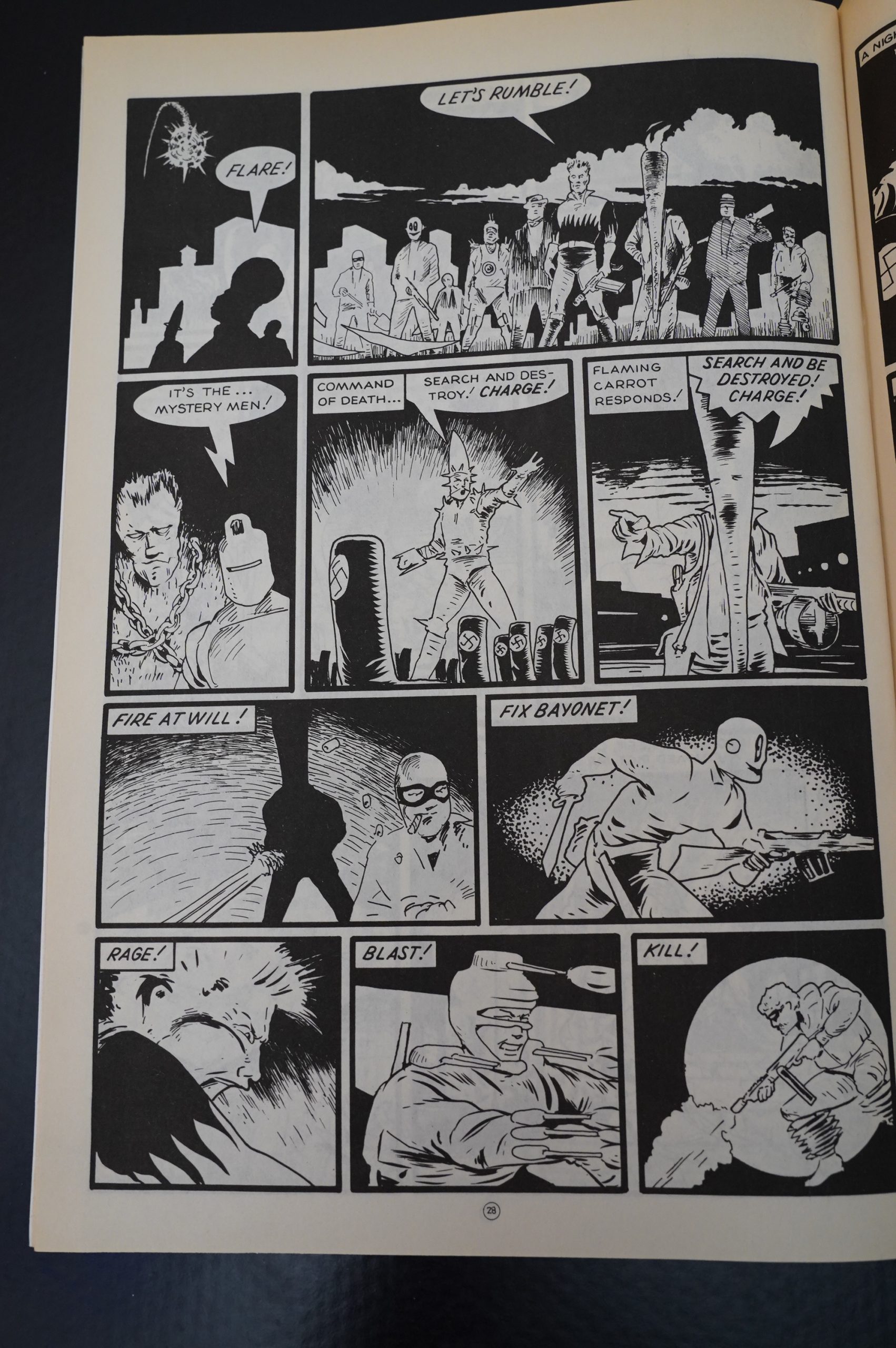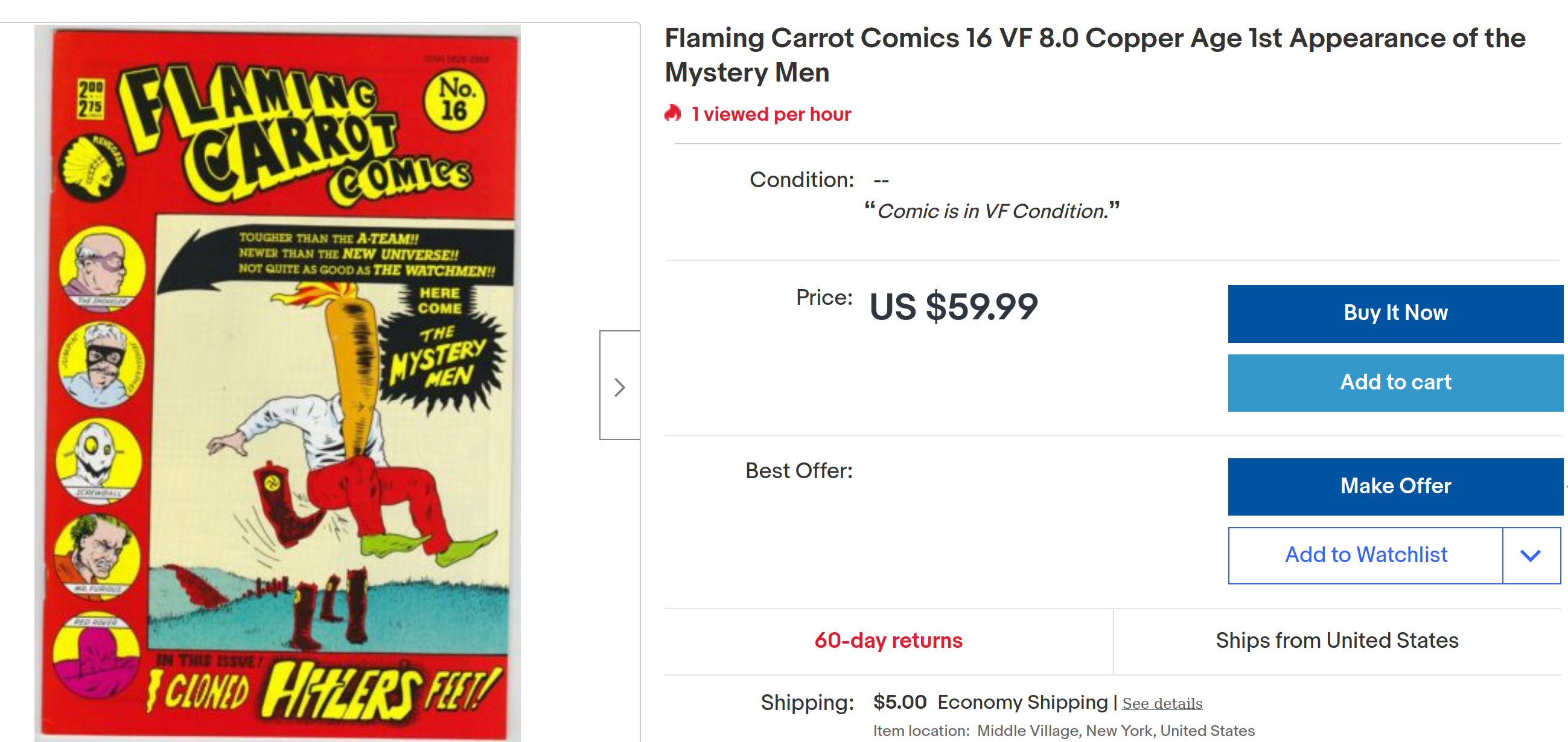Flaming Carrot Comics (1984) #1-4,
Flaming Carrot Comics (1985) #5,
Flaming Carrot Comics (1985) #6-17
by Bob Burden
I think I said in a previous post in this blog series that the only Aardvark-Vanaheim book I didn’t buy as a teenager was normalman?
I’d forgotten about Flaming Carrot: I only got a couple of issues at the time. I seem to remember there being two reasons for that. The first was that I started reading the series with issue six or something, and it was difficult getting the previous issues? I may be misremembering; that sounds like an odd thing for me to do…
And the other was that I found the couple of issues I had bought to be rather tedious.
But I know that Flaming Carrot has rabid fans, and sometimes hydrophobia happens for a reason, so let’s see…
Well, that’s satisfyingly absurd. It’s also graphically interesting: The lack of crosshatching coupled with the black-spotted elements and the general abundance of white space is very distinctive. So is the linework: Somewhat heavy outlines (mostly of non-varying line width) coupled with thin, wispy interior lines…
And faces that are downright bizarre, but work in this context.
There’s pop culture references, of course, but usually not very recent ones.
The humour is mostly absurd non sequiturs, and they’re pretty inspired.
The second and third issues are older Flaming Carrot stories (and issue two was drawn in a magazine size ratio). Burden says later that he wanted to start the series with this stuff, but the publisher didn’t think that was a good way to draw in new readers (there’d already been a Flaming Carrot #1 self-published by Burden under the name Killian Barracks), and I think they had a point.
I had expected more stuff like this, but I think this is basically it?
For an absurd humour comic, there’s a surprising amount of bloodshed.
I’m also surprised that Burden finds it necessary to insist on the chronology…
… but it turns out that the story that starts in #1 and continues in #3-11 is actually kinda sorta tightly plotted: It’s got a swarm of different characters that we follow, and their storylines mostly connect up, and we get a climax in #11. I had not expected so much plot — I thought it was just going to be absurd jokes.
There aren’t that many back-up strips. Here’s Dreams of the Taco Fiend, but Burden will (in most issues) have a 26-32 page Flaming Carrot story, and the rest is letters pages and Burden talking to us.
Flaming Carrot’s origin is that he read 5K comics in one sitting and turned deranged… I know the feeling.
Anyway, we get these recaps every issue, which is nice.
Oh! The carrot is a mask! I thought it was his head.
(It’s a) Crime Comics by Jerry Siegel and Valentino? I don’t think that ever happened? Deni Loubert had a tendency to be overly optimistic when announcing new books.
Oh, I should probably say something about the plot(s) in these issues… it’s basically the Soviets infiltrating/invading the US: A very 80s plot.
Even if the individual story beats are… er… unique. (And isn’t green a primary colour already in the additive colour system?)
Reading these issues, I was struck by similarities to the era we’ve just been through. For instance, FAKE NEWS is a recurring theme: The media is always lying to the public.
Sometimes Burden’s faces go very strange.
Wow. That’s a very Moebius-like panel.
Anyway, the communists finally take over (after winning the election (they spiked the water supply with LSD))…
… and Flaming Carrot organises the resistance, uniforming them in “Hawaiian aloha flowers”. This is spookily prescient, right? RIGHT!?
The denouement of it all is the head communist being stabbed by his own speech balloon, which is somewhat untypical of Flaming Carrot: The humour doesn’t go meta all that often.
OOPS SPOILERS
Apparently there’d been some pushback on using communists as the villains in The Comics Journal? Hm… “Podhoretzian”…
Ah:
John Mordecai Podhoretz is an American writer. He is the editor of Commentary magazine, a columnist for the New York Post, the author of several books on politics, and a former speechwriter for Presidents Ronald Reagan and George H. W. Bush.
R. Fiore writes in The Comics Journal #102, page 36:
Oddly enough, the odd Bob Burden
of Flaming Carrot puts forward the whole
Podhoretzian (the Russians are
behind everything from El Salvador to
heroin traffic) without a hint of irony that
I can detect, but the subplot just seems to
lie there.[…]
I don’t expect the trend to continue long.
Not because of any ideological reason, but
simply because the independent comics
makers will realize, as their mainstream
counterparts did long ago, that communists
make lousy villains. In the ’50s and ’60s it
looked like a simple transition: Take out
Part A (Nazis) and replace it with Part B
(Russians). On the surface it looks like a
natural. You couldn’t ask for a more mur-
derous bunch of lying bastards, and there
doesn’t seem to be a single good thing about
them. .But from the start the thrill was just
not there. Despite all their real—world
villainy they were and are deficient in every
other quality that made the Nazis the
greatest villains ewer.
R. Fiore writes in The Comics Journal #111, page 47:
I want to congratulate Bob Burden on
having enough sense to rebut this column
in a forum where I can’t get in the last word.
(Why didn’t you mention it by name, Bob?
Scaredy cat or something?) If nothing else,
it did clear up the question of his being a
Podhoretzian (“Congratulations, Mr. Fiore,
you’re the father of a nine pound, seven
ounce uglyism!”): he’s not joking; he means
it all. It was the usual automatic- defense
mechanism: a.) Communism is a black that
makes all else white; b.) I am anticom-
munist; c) Therefore, anybody who criticizes
me is pro-communist. For anyone with a
similar defect in perception, my squib about
communist villains in Joumal #102 criticized
no one for being anti-communist, including
Burden. I’m an anarchist; I don’t like any
of the bastards. I weas merely speculating on
why, for all their actual villainy, communists
make lousy pop culture villainy.
We get an insight into the seriousness of
Burden’s red menace in Flaming Carot #11,
in which he picks on poor, dopey old Gus
Hall. Gus Hall has been the chairman of
the American Communist Party (or what-
ever they call it) for something like 40 years,
no doubt kept on because his conspicuous
lack of success proves his ideological puri-
ty. Why anyone would get worked up over
an ineffectual, antiquated stooge when neo-
Nazis are knocking over armored cars,
assassinating radio personalities, and
shooting up schoolhouses is one of those
mysteries of surrealism. I guess old Gus is
still a main character in the John Birch
Society Blue Book or something. And I
promised I was going to lay off this political
crap for a while.
So Burden says that he is “APOLITICAL”, and then goes on on a rant about how evil Marxists are… “The minute a Communist country thinks it can win a war, it will strike. This is the universal axiom of truth.”
After the grand Communist thing (which was both surprisingly amusing and surprisingly coherent as an epic story), the rest of the series (well, at least the Renegade issues, which is all I’ve read) are virtually all single issue stories, like this one about a floating dead dog.
Hey, they did a t-shirt with Bob Burden’s Renegade logo. (Flaming Carrot was the only book that used this logo.)
The remaining issues are amusing, but the tone veers wildly — this isn’t very funny, after all.
But then this is.
That’s an impressive increase in circulation… but this was during the black and white boom bust years (when all black and white comics sold well)… and I guess the bust hadn’t happened yet.
Finally. Hitler’s cloned feet.
And Burden reprints a zany golden age story (the only non-Burden material in the series).
I don’t know?
Issues #16 and 17 introduce The Mystery Men, so:
#16 was more expensive than the rest, because The Mystery Men were adapted into a movie a decade or two later.
And that’s it. Flaming Carrot then moved to Dark Horse as Renegade was starting to shut down.
So… I guess reading these comics was pleasant enough, but… I don’t think it’s funny enough? It should be funnier?
Burden is interviewed in Comics Scene Volume #2, page 26:
In fact, Burden almost shies away from
taking responsibility for dreaming up the
character.
“Most people create things by putting
two things together,” he says. “They take a
horse and put wings on him. But I’ve never
worked that way. Flaming Carrot just
came out of the blue and I wrote it down.”
But when pressed, he owns up to a
bizarre array of Carrot influences.
“At the time, I was reading All in Color
for a Dime. In that book, they were talking
about the Fin. The Fin was this Golden
Age character who was preposterous. If
he walked into a room—he had a two-foot
fin on top of his head—he would have to
bend over to get in the doorway.The Flam-
ing Carrot is in the same vein. If he was
going in anywhere, he would burn up
the ceiling.”
Dale Luciano writes in The Comics Journal #73, page 43:
Several pages in Flaming Carrot Comics
were also created to tie in with the “New
Wave” movement in rock music—hence,
the plotline prominently featuring the “ln-
visible Jackets” and FC’s bout with “New
Wave” rock. (In fact, Burden created some
of this material for Mod but it was never
used.) Uhhhhhh…yes, now, let’s see,
where does all this leave us? With a comic
book that is good for some laughs but
which stops short of being genuinely good
by virtue of its inability—or reluctance—to
transcend simple genre parody. Parodies of
banal material always run the risk of being
a bit banal themselves—it happens here—
and the concept of Flaming Carrot Comics
lacks any sort of poetic resonance in execu-
tion. As an artist, Burden creates and
draws his stories in phenomonally brief
explosions of energy—he drew the first
Flaming Carrot story ever in one night
—and the speed shows. There’s a manic
energy about the enterprise that’s momen-
tarily intoxicating, but also a hit-or-miss
quality to the jokes ond the absence of an
over-all vision.
RA Jones writes in Amazing Heroes #54, page 58:
If goofiness was gold, Bob Burden
could buy the planet! I had no idea
what to expect when I opened my
mail to find a black-and-white
booklet entitled Flaming Carrot
Comics. On the cover I see a man
wearing flippers on his feet
giant blazing carrot•ask on his
head—at least I think it’s a mask.[…]
The book does have its comic
moments (no pun intended), such
as when the aliens zap pregnant
women with a ray which causes
them to give birth to Nazi babies!
Such few and far be-
tween however, and far too little to
save this book from sliding into
sheer silliness.
In both story and art, Flaming
Carrot seems to have crawled from
the crypt where most underground
comics are now buried. •l can
somehow picture Bob Burden site
ting at his drawing board, laughing
maniacly at humor the rest of us
will never perceive.
The graphics are crude featuring
humans that look nearly as bizarre
as the aliens. It’s easy to see how
Flaming Carrot became a hero on
whatever Earth he inhabits (Earth
A—for absurd?); everyone else he
encounters is as stupid as he!
Aardvark-Vanahein intends to
take over publication of Flaming
Carrot Comics. I don’t know why
they’re bothering. They have a
gourmet delight in Valentino’s
normalman—they don’t need this
rabbit food reject.
Lee Wochner writes in The Comics Journal #107, page 50:
Throughout the book, Burden continues
his theme of parading the shortcomings of
super-hero comics as literature not only
because of their content but also their struc-
ture. Super-heroes tend to have secret iden-
tities. What is the Carrot’s? Readersare in.
vited to send in their own nominations; the
list so far includes Boris Badenov, Little
Richard, Ernie Bilko, Barney Fife, and Bruce
Lee. Burden also responds this way to a
reader in issue who wonders if the Car-
rot will team up with other comics charac-
ters of his ilk, as most Marvel and DC
characters do: “Team up. Team up. I think
that’s something Marvel started. let’s see,
•are have the Carrot, Herbie JR.
Bob Dobbs, the Badger, Zippy Elwood
Dowd… I can see it now, a new super-hero
called The Strange Rirade battling Dog
Boy and Benb.”
Burden ftrrther taunts his readers by
agreeing the Carrot needs a sidekick and
then considering the notion of a dog in a
carrot mask: “The idea of a dog barking in
muffed tones with his head inside a Car-
rot mask and performing super feats of bold
daring struck me pretty hard. I have a small
selection of comics in my archives that have
humanistic animals in action, such as a copy
Of Rex The Wonder Dog with Rex swinging
on a vine held in his mouth and knocking
the villains off a tree limb with his
Flaming Carrot was sporadically published over the next two decades, and a total of 36 issues was eventually published.
There’s some reviews around the interwebs:
I’m fully aware that the entire story ends up being something of a shaggy dog tale, but the stream-of-consciousness narrative entertains me greatly, especially in the digressions and side-bits like the Hobo Jungle and the Martian broadcasts.
Flaming Carrot Comics will no doubt win over any comic fan or comedy enthusiast that discovers this wonderful series for the first time as the neo-surrealism and comedic tone really helps set this series apart from the traditional superhero romp, therefore making this a must-read for anyone who wants to indulge in something crazy.
This blog post is part of the Renegades and Aardvarks series.
